




He A lTHCA re | Work F or C e | e d UCAT ion | Po PU l AT ion | Governmen T Tr A n SP or TAT ion | e ner G y And P U

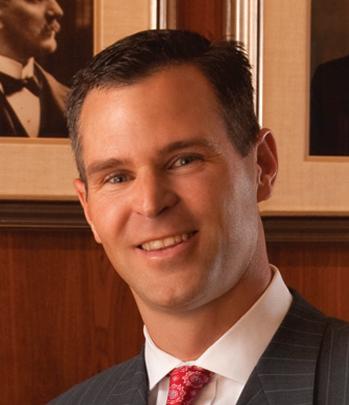
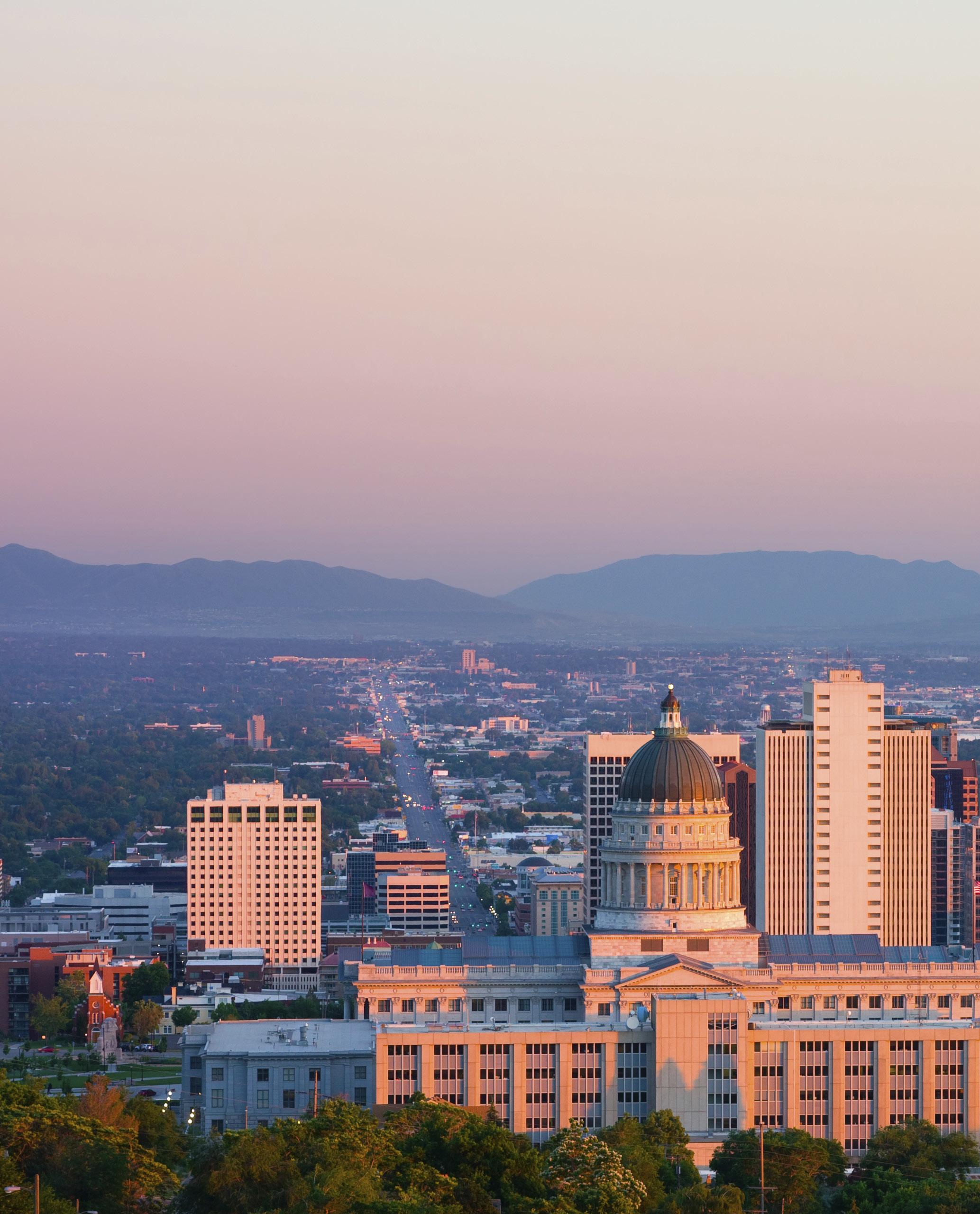
Friend oF eConomiC develoPmenT:
Utah is often praised in the media as a great place to live and work. This publication will give you a better idea of why the accolades continue.
Whether you enjoy the snow-capped mountains or the red sandstone deserts, the Utah landscape is filled with variety. The State’s business landscape is just as diverse. Utah is home to leading companies in high-tech, life science, finance, outdoor products and recreation, with a broad array of industries in between.
As you read the official publications of the Governor’s Office of Economic Development, Utah Facts or Business in Utah, I am confident that you will discover what 3 million Utah residents already know: this is an unparalleled place to build a business and live life to its fullest.
We invite you to explore the many facets of the nation’s “Best Place for Business and Careers.” Utah works diligently to nurture an environment where businesses can flourish. Utah’s extraordinary growth, vibrant and creative business community is sustained by a productive workforce, low taxes and highly innovative research universities.
The Utah Governor’s Office of Economic Development is collaborating with business and thought leaders to strengthen our broad economic base.
We invite you to join us as we build on Utah’s successful heritage.
Sincerely,
Spencer P. Eccles ExECUTIvE DIrECTOr, UTAh GOvErnOr’S OffICE Of ECOnOmIC DEvElOPmEnT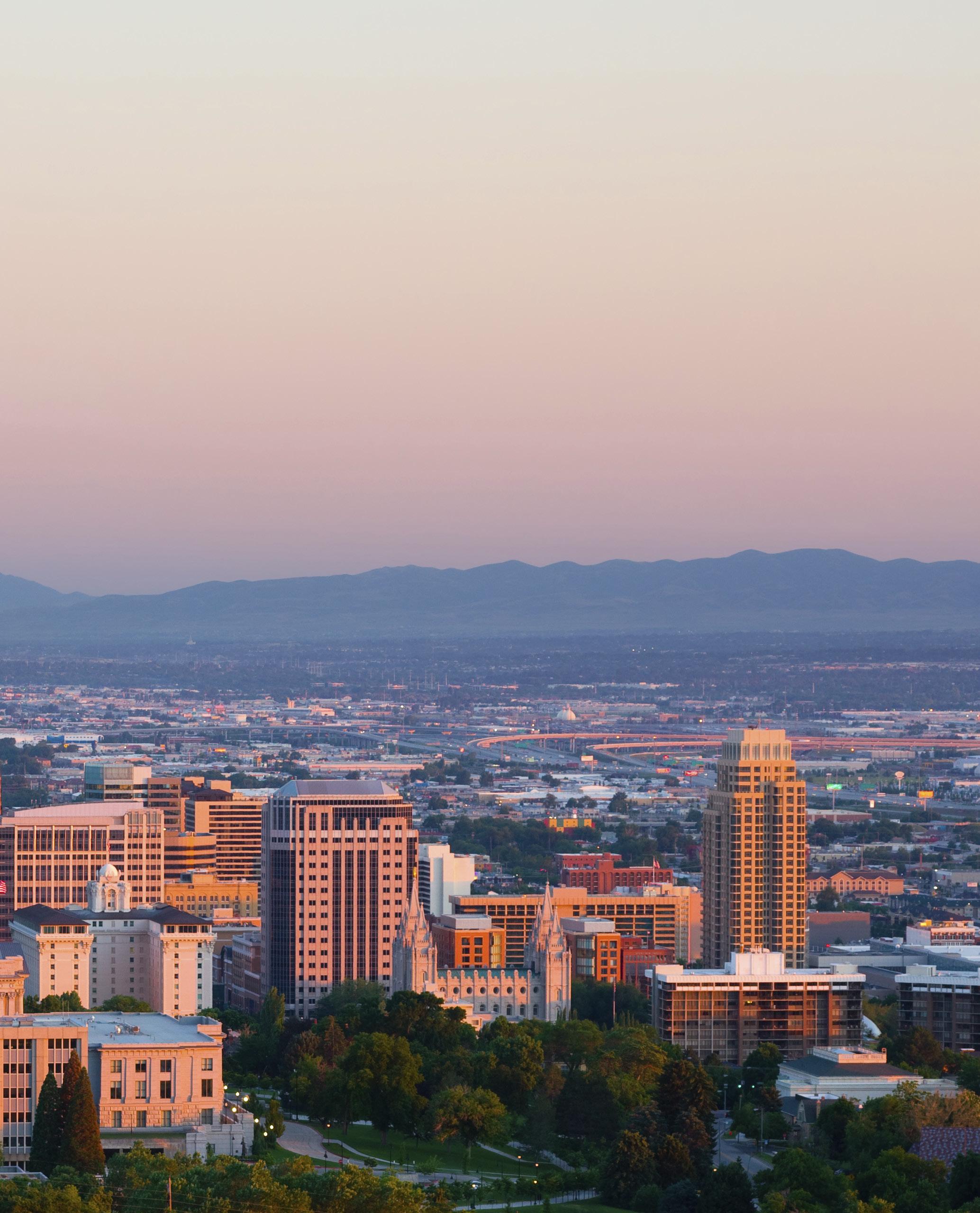


Utah has one of the nation’s highest job growth rates of approximately 3%.
Salt lake City ranked as the nation’s most productive city in 2011.
Utah topped the 2010 and 2011 Forbes list as the Best U.S. State for Business and Careers.
intermountain healthcare is Utah’s largest private employer.
In 2011, Utah’s nonagricultural employment increased 2.6 percent, dwarfing the national average of 1.5 percent.
Utah is a right-to-work state, with only about 6 percent of employees affiliated with unions, compared with 12 percent nationally.
Source: Utah Department of Workforce Services.
Utah continues to live up to its billing as the most dynamic state economy, and as the state best-positioned to weather and recover from an economic downturn. Utah’s unemployment rate in January 2012, 5.7 percent, was far below the national average of 8.3 percent, down from the state’s 7.5-percent rate from January 2011.
The state’s 2009 median household income, $54,744, ranked 14th among the states, according to the Census Bureau.
Utah’s nonagricultural employment jumped an estimated 2.6 percent (30,300 jobs) between January 2011 and January 2012, compared with a national rate of 1.5 percent, according to the U.S. Bureau of Labor Statistics. The strongest growth industry for Utah is professional and business services, which added approximately 6,000 new positions from January 2011 to January 2012, primarily in the high-paying professional and technical industries like legal services, computer systems design, consulting, and market research. Education and healthcare grew by an estimated 4,800 positions over the same period, as did manufacturing jobs. The trade and transportation sector registered an increase of about 4,400 jobs. Utah’s Department of Workforce Services projects that job growth will be at about 3 percent for 2012.
Utah’s robust job growth is fostered by an exceptional business environment.
•Business Facilities named Utah first in the nation for “Best Business Climate.”
•Forbes magazine named Utah first in its 2011 “Best States for Business and Careers” for the second consecutive year.
•The vigor of Utah’s entrepreneurs and government helped the state rank second on the Pollina list of “Top 10 Pro-Business States” for in 2011, for the third consecutive year.
•The Census Bureau ranks Utah third among U.S. states for overall economic health in 2011.
•The Kauffman Foundation’s most recent (2010) State New Economy Index ranked Utah first in the nation for Economic Dynamism, #1 for Inventor Patents and #3 in Fastest Growing Firms.
The economic know-how and fiscal discipline of Utah’s state government positions Utah at the top of U.S. has garnered considerable recognition and positions the state for long-term financial strength and stability. In 2011, the American Legislative Exchange Council ranked Utah first for “Expected Economic Recovery” and “Economic Outlook” in its comprehensive “Rich States, Poor States” study. www.alec.org/docs/RSPS_4th_Edition.pdf. Newsweek/The Daily Beast named Utah’s capital city as one of “10 Places in America” poised for recovery, describing the Salt Lake valley as one of three “New Silicon Valleys” that combines high-paying tech jobs with low living costs.
Utah’s low taxes, disciplined spending, light regulatory burdens, and sound, insightful economic policy approach have enabled Utah to finish first overall in the most recent Forbes State by State Debt Weight Scorecard. The state is one of the few U.S. states to maintain AAA bond ratings from both Moody’s and Standard & Poor.
Utah’s top-tier economic performance and dynamism are driven by a highly productive workforce with strong fundamentals, which translates into an exceptional business climate. Entrepreneurs and other high-level executives running businesses in the state note the high levels of dedication and knowledge they find among workers and potential employees. The state’s highly educated workforce enjoys the nation’s highest literacy rate (94 percent) and ranks seventh in the nation in the percentage of people 25 years and older (90.6 percent) who have completed high school.
Utah’s workforce is also highly technologically proficient and multilingual. The state consistently ranks at or near the top of states for technology use among its population. In an increasingly global economy, the unusually high level of multilingual capability in the state’s populace translates to a more flexible and capable workforce. Many Utahns have lived and worked abroad, which greatly enhances their ability to make an immediate contribution to the success of Utah-based companies and divisions that operate internationally. Approximately 80 percent of students at Brigham Young University are multilingual. According to the Utah Governor’s Office of Economic Development, more than 130 languages are spoken in the state. Employers find the health, youth and vitality of Utah’s workforce to be a great asset. Utah has the highest birthrate and youngest median age in the nation (see Population chapter in this book), and ranks among the nation’s healthiest states (see Healthcare chapter). The 2011 edition of the United Health Foundation’s America’s Health Rankings found Utah to be the seventh healthiest state in the United States, with the country’s lowest prevalence of smoking, the lowest incidence of cancer-related deaths, and the lowest income disparity. Utahns enjoy the sixth longest life expectancy in the nation, at 80.1 years, according to the U.S. Census Bureau.
Utah cities and their inhabitants rank among the top U.S. places to do business.
•Salt Lake City’s workforce ranked first in the U.S. for productivity in 2011, according to the Brookings Institution’s Metropolitan Policy Program. The Ogden-Clearfield metropolitan area ranked 13th.
•Ogden topped the nation in job growth from August 2010-August 2011, according to the U.S. Census Bureau.
•Logan ranked first in the Milken Institute’s list of “The Best Small Cities for Business.”
•In the 2011 Milken Institute’s “Best Performing Cities” index, Salt Lake City ranked sixth (up from 53rd in 2010), Provo-Orem ninth (up from 25th) and Ogden-Clearfield 15th (up from 78th).
Data comparisons also show that Utah’s more experienced workers are highly competitive against their national counterparts. This trend will continue to maintain the state’s favorable household income ranking. Utah’s young working population is a tremendous positive for business today and for the foreseeable future.
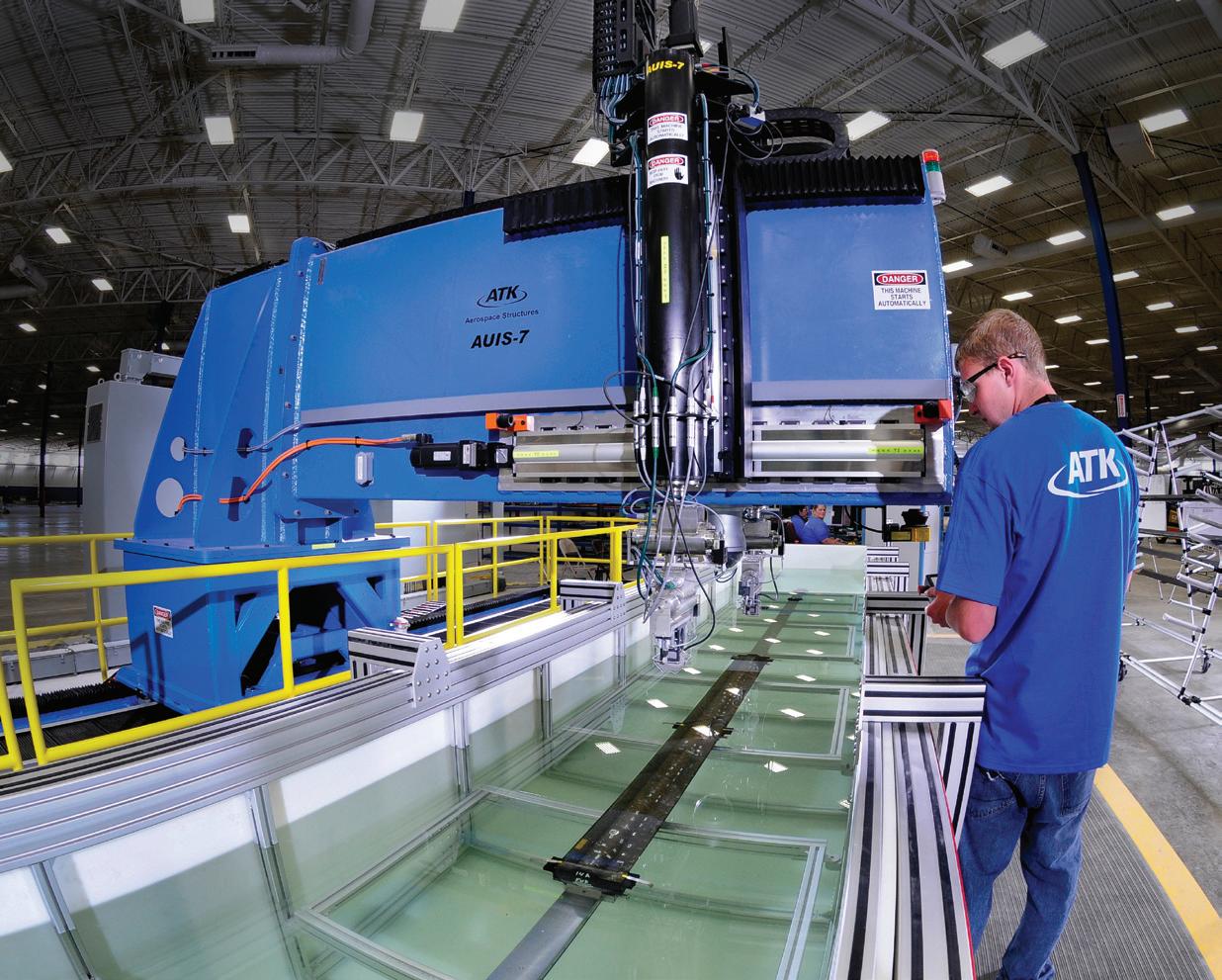
Utah has been an innovative leader in the implementation of programs that provide specific worker training and education to better fit their skills to the growing and evolving needs of the state’s dynamic companies, as the following examples illustrate.
Begun in 2008, the Incumbent Worker Training Program, sponsored by the Utah Department of Workforce Services (DWS), uses a computerized system to match applicants with qualifications set by hiring companies. The program provides qualified employers with matching grants for expenses related to training workers in new job-related skills. Employers develop a detailed training plan that addresses specific skills required in their businesses and how the training will benefit not only the employee and the company, but also the larger community. The program has been in high demand with employers who are able to train for specific positions requiring specialized skills and knowledge that have been especially hard to fill in Utah’s tight labor market.
Another innovative employer/employee job-matching program, Short Term Intensive Training (STIT) programs generally last less than one year, and are customized to meet the requirements of companies’ actual full-time job openings. Potential employers and employees pay tuition to participate, but STIT maximizes the changes of pairing qualified applicants with quality jobs. Currently, state funding for STIT programs is distributed to Weber State University, Southern Utah University, Salt Lake Community College, Utah Valley University and the College of Eastern Utah.
Intermountain Healthcare Healthcare
University of Utah (Including Hospital) Higher Education
State of Utah State Government
Brigham Young University
Higher Education
Wal-Mart Associates Warehouse Clubs & Supercenters
Hill Air Force Base
Granite School District
Federal Government
Public Education
Utah State University Higher Education
Davis County School District
Alpine School District
Public Education
Public Education
Smith’s Food and Drug Centers Grocery Store
U.S. Department of Treasury Federal Government
Salt Lake County Local Government
U.S. Postal Service
Jordan School District
Federal Government
Public Education
The Canyons School District Public Education
ATK Launch Systems Aerospace Manufacturing
Zions Bank
Mangement Services Banking
Weber County School District Public Education
Delta Airlines Air Transportation
Convergys Corporation
Telephone Call Center
Salt Lake City School District Public Education
Wells Fargo Bank Banking
Utah Valley University
Higher Education
Nebo School District Public Education
Salt Lake City Corporation Local Government
SOS Temporary Services Temporary Help Services
L3 Communications Corporation
SkyWest Airlines
Source: Utah Department of Workforce Services
The Davis Applied Technology College (DATC) is a novel workforce training institution that helps support Utah’s fast-growing, high-performance composites business with qualified workers and technicians from within the state’s current workforce. The program supports focused marketing and recruitment efforts to encourage new or transitioning workers to move into the composites industry. Besides core composites-specific knowledge and skills, the DATC curriculum also includes job seeking/keeping skills targeted at improving worker placement and retention. The college works in close partnership with a wide variety of educational institutions, corporations, societies and governmental agencies.
Another innovative program that benefits both employers and employees in Utah is Custom Fit, a collaborative partnership between Salt Lake Community College, various Utah Applied Technology Center campuses, strategic partners and local businesses across the state, which provides relevant customized training that leads directly to jobs. Contract processing can happen as quickly as 15 to 21 days.
Utah is one of 23 U.S. states operating under a right-to-work law. Under the Utah provision, no individual seeking or holding a job in the state may be forced to join or pay dues to a labor union, nor conversely prevented from joining a union and/or engaging in collective bargaining. Union membership is low in Utah, with less than 6 percent of manufacturing employees affiliating with unions, compared to a national average of about 12 percent.
The list of Utah’s largest employers includes a blend of public and private organizations. Three organizations in the state employ more than 20,000 workers each: Intermountain Healthcare, a statewide network of hospitals and clinics; the State of Utah; and the University of Utah. Brigham Young University and Wal-Mart are the next-largest employers, with 15,000-19,999 employees each. Hill Air Force Base, a military installation in the Ogden area, is currently the only Utah organization that employs between 10,000 and 14,999. Two major school districts—Granite and Davis—and Utah State University each employ between 7,000 and 9,999 Utah residents. The Alpine School District, Smith’s Food and Drug Centers, the U.S. Department of the Treasury, Salt Lake County, the U.S. Postal Service and the Jordan School District each employ between 5,000 and 6,999 in Utah.
Electronics Manufacturing
Air Transportation



Utah consistently ranks among the healthiest U.S. states.
The average life expectancy for Utah’s population, 80.1 years, is tied for the nation’s sixth-longest.
The fast-growing Utah health exchange, launched in 2008 with the support of the Utah legislature, is an innovative consumer-centric health system.
Two Utah hospitals— Primary Children’s medical Center and the University of Utah hospitals—have been recognized among america’s Best hospitals by U.S. News & World Report.
Utah’s healthy, highly productive citizenry enjoys access to world-class healthcare delivery and a dynamic, innovative life science sector.
According to the U.S. Department of Health and Human Services, Utah’s population has the sixth-longest life expectancy in the nation, at 80.1 years. Utah has also ranked among the seven healthiest states for each of the last 20-plus years, based on statistics compiled by the United Health Foundation.
The Beehive State ranked 7th in 2011, as it did the previous year. In all, Utah ranked among the top 10 states in 22 of the measures used by the Foundation in assessing a state’s overall health.
Utah is a national and global leader in healthcare innovation and in highquality, cost-effective healthcare delivery. Exceptional medical care is available throughout the state; 50-plus hospitals house more than 5,000 staffed beds. Citizens in the state’s densely-populated Wasatch Front region enjoy access to a wide array of major medical facilities, including 19 hospitals in Salt Lake County, four in Utah County, four in Davis County and two in Weber County. Utahns in rural Utah are served by systems such as St. Mark’s Hospital and Intermountain Healthcare, which have earned high praise for bringing quality healthcare to low-population-density areas throughout Utah. Utahns also enjoy ready access to a number of national and regional health plan providers as well as employee group benefits providers that service employers of all sizes. Intermountain Healthcare is frequently used as a national model healthcare system. It repeatedly ranks among the top integrated U.S. healthcare systems, including 4th in 2011, by SDI, a major health information organization. SDI’s annual study of more than 500 U.S. health systems focuses on clinical quality, operations, and efficiency and breadth of services. The company’s findings are reported in Modern Healthcare magazine. Intermountain has ranked in the top five U.S. systems for 13 consecutive years.
The University of Utah Health Sciences programs include: University Hospital, the Huntsman Cancer Institute, the University Neuropsychiatric Institute, the nationally ranked School of Medicine and the colleges of Nursing, Pharmacy and Health. Individually and collectively, the programs have achieved high national stature for their patient care, research and teaching facilities. In addition, St. Mark’s Hospital and other Utah healthcare providers have garnered national and global recognition.
The Veterans Administration (VA) Center for Genomic Medicine Patient Care Services, adjacent to the University of Utah campus, focuses on groundbreaking biomedical research, patient care, clinical translation, informatics, drug discovery/development, device design and ethics policy for the nation’s largest single health provider. The VA has developed the world’s largest biobank, and is actively pursuing novel approaches to prevent and treat illness for U.S. veterans and other Americans.
Hospitals at the University of Utah and Intermountain Healthcare were among only 140 hospitals (among 4,825 facilities analyzed) to rank in the 2011-12 Best Hospital Rankings in one or more of 16 specialties by U.S. News & World Report These Utah hospitals were ranked in the following categories:

UnivErSiTy Of UTah hEaLTh CarE #50 in Ear, Nose and Throat #47 in Gynecology
Primary ChiLDrEn’S mEDiCaL CEnTEr (Intermountain Healthcare)
#38 in Pediatrics: Cancer #31 in Pediatrics: Cardiology & Heart Surgery #32 in Pediatrics: Gastroenterology #49 in Pediatrics: Neonatology #35 in Pediatrics: Nephrology #6 in Pediatrics: Neurology & Neurosurgery #32 in Pediatrics: Orthopedics
uTA h’S Im PACT fu L hEALT h ExC h A ng E
Another national model for healthcare is the Utah Health Exchange, developed by the State Legislature and Governor’s office. The development of this program was driven by the state’s far-reaching commitment to the health and well-being of its citizens. The Utah Health Exchange serves as an innovative model and is one of the nation’s first statewide private sectordriven healthcare exchanges.
Beginning in 2005, Utah State government leaders began to lay the groundwork for a program designed to empower consumers—individuals, businesses and organizations alike—to take control of their own healthcare, with the information and resources they need to make effective healthcare decisions and to execute those choices.
The program was established through three pieces of legislation. House Bill 133 (2008) and House Bill 188 (2009) directed the State’s Office of Consumer Health Services to create an Internet portal to facilitate requirements specified in Utah’s Health System Reform legislation. House Bill 0294 (2010) augmented the program with enhanced transparency. As of January 2012, more than 250 small businesses employing 5,500plus employees were involved in the exchange, with additional companies entering the system each month. Further information about the Utah Health Exchange can be found at www.exchange.utah.gov.
other top 10 Finishes:
violent Crime (5th); infectious Disease (6th); overall (7th); premature Death (7th); Children in poverty (9th); health Status (9th); Median household income (10th); Stroke (10th); and low Birth weight (10th).
Health Rankings by the United Health Foundation

ExTE n DI ng uTA h’S mEDICAL D E v ICES A n D B IOTEC h L Eg ACy
The citizens of Utah, and the world, continue to benefit from the state’s leading position in life sciences research and commercialization. Utah’s research universities and entrepreneurial life science companies continue to build innovative products and services in areas ranging from medical devices to molecular diagnostics, specialty pharmaceuticals and targeted drug delivery systems.
Utah is a perennial medical device innovation leader, whose organizations continue to expand on the legacy established by global pioneers such as Willem Kolff, father of artificial organs; prolific medical device inventor James LeVoy Sorenson, who garnered 40 patents during his lifetime; and Homer Warner, co-creator with Sorenson of the first systems for real-time monitoring of the heart.
In biotechnology, innovations in molecular diagnostics, genetic research and databases, and other advanced technologies will continue to keep Utah in the forefront of this fast-changing industry. For example, to date, the University of Utah has identified more disease-related genes than any other university in the world and produced Nobel Prize winning research in the person of Mario Capecchi.
In December 1984, stranded at first in a driving snowstorm, some of the world’s leading life scientific researchers met at the Alta Ski Resort in Utah’s Wasatch Mountains. The meeting established many essential elements of what ultimately developed into the Human Genome Project.
For more than 30 years, generations of Utah families have contributed to epic DNA research projects through the Utah Population Database (UPDB). The unique lineage and demographic profiles of these families make this data a rich global enabler of advanced DNA research. The UPDB is the world’s largest and most comprehensive data source of its kind. Researchers have used this resource to identify and study families with higher-than-normal incidence of cancer and other diseases to analyze patterns of genetic inheritance and identify specific genetic mutations. In addition, demographic studies have shown fertility trends and changes in mortality patterns.
Utah’s large, stable families continue to produce a treasure trove of knowledge about human kinship. Utah DNA is being utilized for international studies designed to identify chromosomes linked to diseases such as asthma and diabetes. Other researchers are studying how the genes for left-handedness or longevity, or even the ability to taste bitter foods, have moved through the Utah gene pool over time. Utah’s nonprofit Sorenson Molecular Genealogy Foundation is compiling a global genetic database that helps pinpoint where an individual’s ancestors came from, and reveal genetic connections with others across the planet. Utah’s Ancestry.com is a global leader in family history identity and exploration.
In 2007, University of Utah human genetics professor Mario R. Capecchi garnered the 2007 Nobel Prize in Physiology or Medicine for his pioneering work on “knockout mouse” technology, a gene-targeting technique that has offered fresh insights into mammalian biology and allowed the creation of animal models for hundreds of human diseases, including cancer.
For the past four years, Utah has hosted the National Summit on Personalized Health Care, launched in partnership with the U.S. Department of Health and Human Services (HHS). Sessions have been led by such leaders as former HHS Secretary and Utah Governor Michael O. Leavitt, legends Leroy Hood and Ralph Snyderman, and disruptive innovation originator Clayton Christensen. The Summit also launched the Roadmap for Personalized Health Care, created to accelerate the development and utilization of transformative technologies, business models, value networks and legislative and regulatory policies to create more effective, less expensive healthcare.
In 2011, the Utah System of Higher Education (USHE) engaged Battelle’s Technology Partners Practice to develop a statewide strategic plan for Utah’s life science sector. With collaborative input from Utah life science leaders in higher education, industry and government, the Utah Cluster Acceleration Partnership for Life Sciences (LS UCAP) study identified core strengths, gaps and opportunities for Utah, together with a far-reaching, detailed execution plan to drive the growth and evolution of this fast-growing industry sector. The UCAP Life Science plan will enter the execution phase in Q2 2012. The State’s life science sector receives guidance and direction from a broad array of strategic support organizations, including: the Utah Technology Council, the trade association for the state’s IT and life science companies (www.utahtechcouncil.org); the Utah Science Technology & Research Initiative (USTAR), which attracts and supports world-class research and commercialization teams to Utah’s research universities (www. innovationutah.com); the Governor’s Office of Economic Development (GOED), including the State Science Advisor, the Cluster Acceleration Partnership and other centers of support for the life sciences (www.business. utah.gov); the Economic Development Corporation of Utah, which partners with GOED to successfully recruit dynamic companies and divisions to Utah (www.edcutah.org); the influential Salt Lake Chamber, which focuses significant energy and resources on workforce development, education and other mission-critical projects (www.slchamber.com); the Intermountain Biomedical Association (IBA), which provides a broad array of education, training and networking experiences for individuals and companies in the Utah bioscience community (www.ibaut.org); and the MD4 Utah Institute (Medical Devices, Diagnostics and Drug Development), which supports the life science community through events, an active portal and newsletter, and strategic iniatives (www.md4utah.org).
For the foreseeable future and beyond, Utah will continue to play a leading role in key biotechnology and genetics-based breakthroughs that impact medical innovation and healthcare delivery worldwide.
primary Children’s Medical Center Salt lake City, UT nationally ranked in 7 specialties
University of Utah health Care Salt lake City, UT nationally ranked in 2 specialties high-performing in 5 specialties
intermountain Medical Center murray, UT high-performing in 8 specialties
Utah valley regional Medical Center Provo, UT high-performing in 6 specialties
lDS hospital Salt lake City, UT high-performing in 5 specialties
intermountain Mckay-Dee hospital Center Ogden, UT high-performing in 4 specialties
Salt lake regional Medical Center Salt lake City, UT high-performing in 2 specialties
Dixie regional Medical Center Saint George, UT high-performing in 1 specialty
St. Mark’s hospital Salt lake City, UT high-performing in 1 specialty
Source: US News & World Report Best Hospitals Study


Utah is a central, highly cost-effective distribution point for the Western U.S.
Salt lake City ranked first in the most recent Forbes study of the Best and Worst Cities for Commuters.
Utah is a one-day truck drive or less from almost every major city in the Western U.S.
Salt lake International Airport is a consistent national leader in on-time performance, and ranked first in 2011.
Salt lake International has more than 626 scheduled daily departures with non-stop service to 90-plus different cities.
main rail lines link Utah directly to the major seaports of los Angeles, Oakland, Portland and Seattle.
Utah’s strategic geographic location in the heart of the American West propels its continuing functional role as “The Crossroads of the West.” Whether by road, rail or air, the state is optimally placed as a hub for distribution. Its capital, Salt Lake City, is essentially equidistant from all major Western U.S. markets, including Los Angeles, San Diego, San Francisco and Seattle. Businesses, residents and visitors all benefit from highly efficient systems for moving people and goods that are part of Utah’s comprehensive transportation infrastructure.
Utah’s comprehensive transportation system includes a top-performing international airport; a centrally-located highway system built around major east-west (I-80, I-70) and north-south (I-15) interstate arteries; two major railroads; and steadily expanding light rail and commuter rail systems. For international freight and traffic, Salt Lake City is a full-service customs port city, and there are additional highway ports of entry throughout the state.
In keeping with Utah’s tradition of forward-thinking and planning, transportation is mapped out into 30-year plans, accounting for projected demographic changes, funding and technological needs and advances. This forward-looking approach has established Utah as a national leader in transportation. Salt Lake City was named as the best U.S. city for commuters in the most recent Forbes Best and Worst Cities for Commuters 2010. For the Utah Transit Authority’s long-range plan, visit www.rideuta.com/mc/?page=Projects-LongRangePlan. For information about the 30-year transportation plan for the Wasatch Front Regional County (comprising Salt Lake County and surrounding counties), visit www.wfrc.com. For information about the Mountainland Association of Governments transportation plan, visit www.mountainland.org.
The Salt Lake International Airport (SLC), located approximately five miles northwest of downtown Salt Lake City, is located within a 2.5-hour flight of more than half the population in the U.S. In 2011, SLC was the 26th-busiest airport in the U.S., serving approximately 20 million passengers. In 2011, there were 357,996 takeoffs and landings at Salt Lake International. SLC offers non-stop flights to more than 90 cities and has more than 626 scheduled flights daily. Salt Lake International is served by seven airlines and their affiliates: American, Delta, Frontier, JetBlue, Southwest, United/Continenta and US Airways.
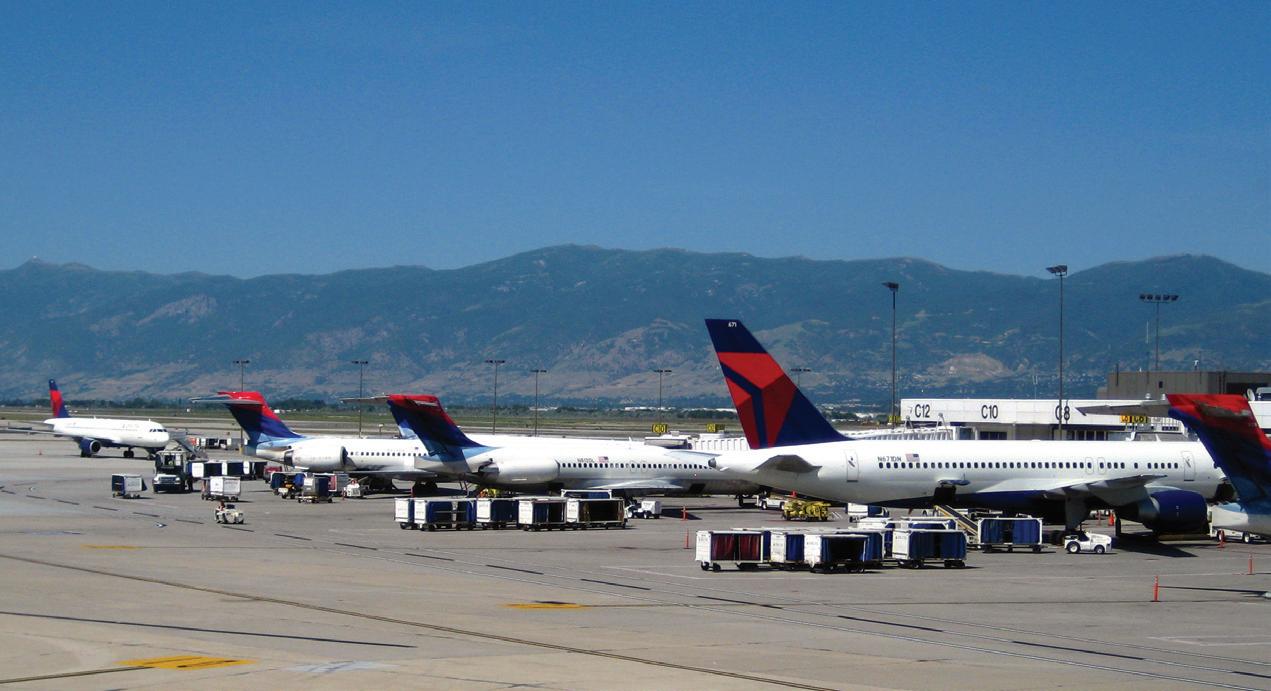
SLC consistently ranks among the best airports in the nation for on-time performance. In 2011, according to FlightStats.com, the airport led the nation in on-time departures, with 86.55 percent, compared with a national rate of 76.67 percent. The airport has recently enhanced its international offerings, with new direct flights to Canada, Mexico, France and Japan. U.S. Customs offers “on demand” cargo and charter flight inspection. SLC is Delta’s secondlargest hub, and the largest in the Western U.S.
SLC ranks consistently in the top 10 in the nation in Condé Nast Traveler magazine’s Business Travel Awards. The annual survey reports business travelers’ impressions of their experience with location/access, customs/baggage, food/shops/amenities and safety/security. The airport has also received numerous international awards for excellence in snow removal. The Salt Lake City International Airport was the first airport to receive accreditation as an Emergency Medical Dispatch Center of Excellence by the International Academies of Emergency Dispatch (IAED).
In 2008, SLC retired nearly $50 million in auction rate bonds, making it the only debt-free large hub airport in the nation. In contrast to many other metropolitan airports, Salt Lake City International has acquired substantial property for the future expansion of services, terminals and runways, in order to ensure the future quality of air service, avoiding the delays, congestion and overcrowding that characterize many airports. SLC’s innovative language translation service, Language Line, provides real-time translation of 250 languages, and free wireless Internet access is available throughout the airport. For more information about Salt Lake International Airport, visit www.slcairport.com.
In addition to SLC, there are plentiful air-travel options located throughout the state for business travelers and vacationers. Global Aviation Navigator lists 141 public and private airports and 51 heliports in Utah, while AirNav. com lists 50 public-use airports throughout the state. For listings of Utah airports visit www.airnav.com/airports/state/UT.html, or www.onlineutah. com/airports.shtml.
Utah continues to benefit from the expansion and improvement of its strategically centered road and highway system. The Utah Department of Transportation (UDOT) is expanding and upgrading the I-15 corridor in Salt Lake County and addressing key areas of Utah County and Davis County in order to further improve traffic flow in the most heavily trafficked areas. Utah’s road transportation system includes more than 93,914 miles of federal, state and local highways and roads, according to the Federal Highway Administration. Approximately 300 highway projects are currently under construction in Utah.
The state’s interstate highways provide efficient access to population and economic centers in neighboring states, while the in-state highways offer effective connections between cities and the state’s many recreation areas. Utah’s two most heavily-travelled highways are I-15, which runs north into
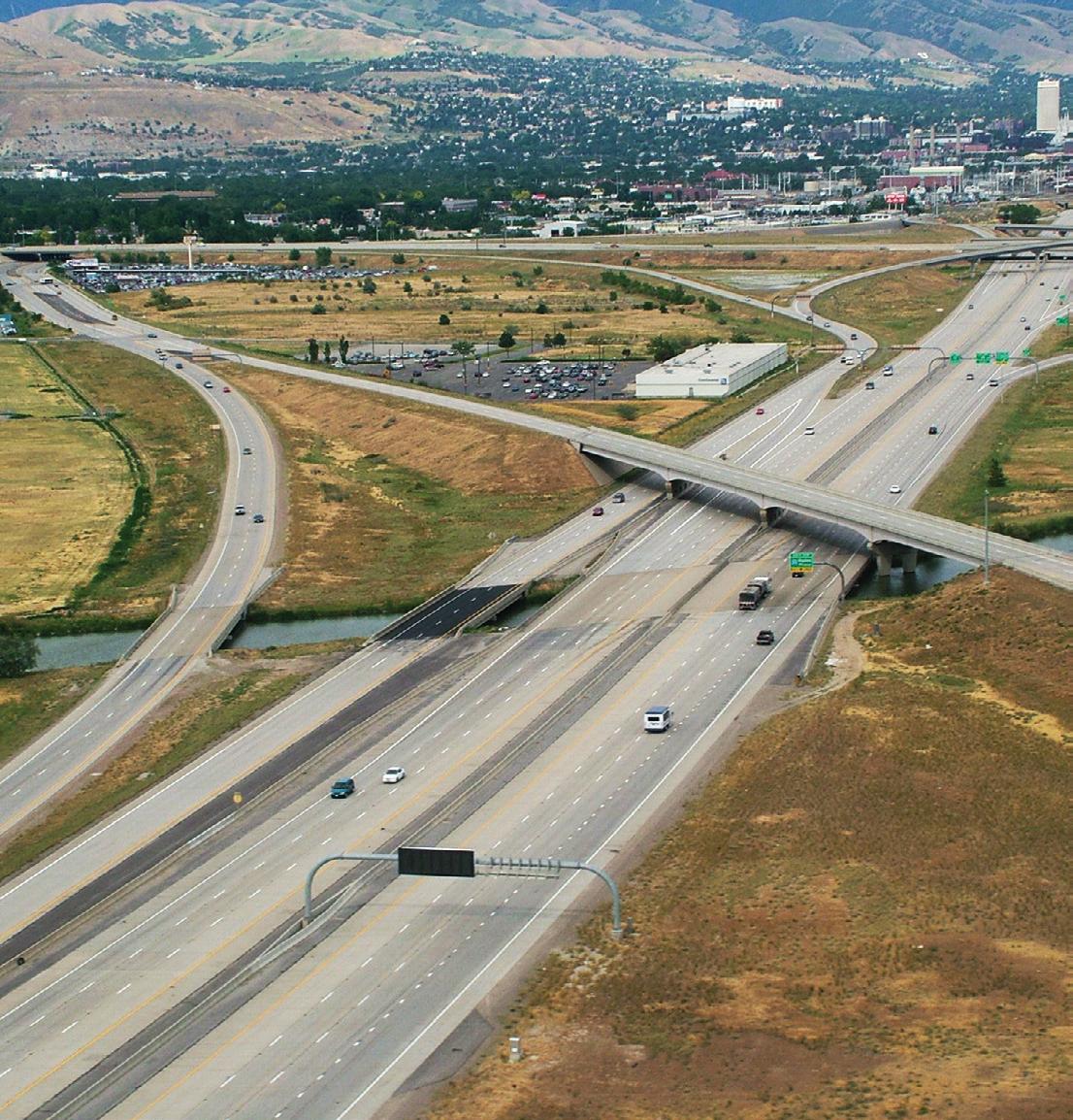
Idaho and south into western Arizona, southern Nevada and southern California, passing through or close by most of Utah’s largest population centers; and I-80, a coast-to-coast freeway that runs west into Nevada and into the San Francisco Bay Area, and east through Wyoming and on to New York.
Other significant interstate highways include I-70, an east-west freeway that begins in the central part of Utah and runs into Colorado and on to Maryland; and I-84, which originates in north-central Utah and runs west through Idaho and the leading population centers in the Pacific Northwest. These interstate highways are essential to the efficient transportation of goods and materials throughout Utah and to locations outside the state. I-215, the Salt Lake County belt route is a major link for intrastate traffic in the metro area. Highway 89 is a key route that connects numerous important commercial centers and tourist destinations in Utah’s red rock country and western Colorado. In addition to the main interstate routes, Utah’s primary and secondary federal and state highways provide easy access to rural areas, including many areas of world-class, unique beauty.
For more information about Utah transportation services, current and planned construction projects, or weather and road conditions, contact the Utah Dept. of Transportation at (801) 965-4000, or visit www.dot.utah.gov.
According to the 2011 Economic Report to the Governor, a projected 232,400 Utahns were employed in Trade, Transportation and Utilities in 2009, a modest decrease from the 2008 number of 235,200. Utah carriers provide service from Utah’s metropolitan areas to almost any point in the Western United States. There are currently approximately 700 trucking companies based in Utah, and intrastate and interstate motor freight services are provided by approximately 2,500 registered carriers. Carriers within the state provide one-day and two-day direct services to any point in the continental Western United States.
According to C.R. England, Utah enjoys the second-lowest shipping rates and the third-lowest average load to truck ratio in the Western U.S. For more information about Utah’s trucking industry, visit the Utah Trucking Association Website (www.utahtrucking.com) or the Utah Department of Transportation (www.udot.utah.gov).
Salt Lake City is a full-service customs port city. Currently, goods that enter under bond may be stored in customs-bonded facilities for up to five years without payment of customs duty. If goods are exported during this period, no duty is paid. Otherwise, duties are payable at the end of the term or upon entry into U.S. markets for consumption. In addition to Salt Lake City headquarters, Utah has ports of entry in Daniels, Echo, Kanab, Monticello, Peerless, Perry, St. George and Wendover. For more information about Utah’s ports of entry, visit www.udot.utah.gov.
Utah has approximately 1,700 miles of railroad track stretching from Iron County in the southwest, Grand County in the southeast, Tooele County in the west and Box Elder and Cache counties in the north. These rail lines converge in the Salt Lake-Ogden metropolitan area.
Utah’s central location makes the state an excellent interline switching route for shipments headed to the West Coast, as well as to eastern and Midwestern main terminals, without the need to back-haul shipments. Union Pacific is Utah’s major freight service provider, while Amtrak provides passenger service to major U.S. destinations.
Utah is an ideal interline switching route for shipments to the West Coast and to Midwest and Eastern main terminals. Salt Lake City is the westernmost point from which all West Coast cities can be served directly by rail without backtracking, with second-morning service to approximately 90 percent of the Western U.S. Union Pacific’s $83-million, 260-acre Salt Lake City
Intermodal Terminal can service 250,000 truck, rail and ocean-going containers annually. Utah employs approximately 1,800 freight railroad employees, with an average salary of more than $96,390 in annual wages and other benefits, according to the Association of American Railroads (www.aar.org/ AAR/KeyIssues/Railroads-States.aspx).
Utah’s mass transit system has expanded considerably in recent years. Currently, the Utah Transit Authority (UTA) serves an average of approximately 70,000-80,000 riders per weekday on its 140 bus lines. Bus service is available throughout most metropolitan areas of the state. Utah’s first TRAX lightrail line, between Salt Lake City and Sandy, opened in 1999, and within less than a year, well over 5 million passengers had taken a ride on the line. More than 4 million riders were transported on TRAX during the two weeks of the 2002 Olympic Winter Games. Since opening day TRAX has far outpaced initial projections of 14,000 combined riders per day on both the Sandy/Salt Lake Line and the University of Utah Line: currently, the system serves 50,000-60,000 riders per weekday.
In addition to its two current TRAX routes, the UTA has purchased considerable railroad corridor along the Wasatch Front for future expansion of the TRAX light rail system, as well as a commuter rail system that will eventually run from Brigham City in the north to Payson in southern Utah County. As a result of its strong start and high acceptance rate—including at the ballot box—the TRAX light-rail system currently operates three lines: eastwest between downtown Salt Lake City and the University of Utah; northsouth between Salt Lake city center and Sandy; and northwest-southeast between Salt Lake City Center and West Valley City. UTA is adding three additional lines in Salt Lake County: to Salt Lake International Airport, Draper and the Mid-Jordan area. All are slated for completion by 2015. Transit studies and planning are also underway in the Sugarhouse, South Davis, Taylorsville/Murray and Ogden-Weber State University areas.
Another significant addition to Utah’s public transit system is a new commuter rail system called FrontRunner—a push-pull diesel train that runs at speeds up to 79 mph that makes fewer stops than does TRAX. The first of two lines opened in 2008 on the corridor between Salt Lake City and Ogden to the north. FrontRunner has rapidly become a major backbone of daily travel for thousands of Utahns.
Construction on the second FrontRunner South line, to run between Provo and Salt Lake City, is slated for completion in 2012, and to begin operations in 2013. The eight stations will include Draper, South Jordan, Murray and Salt Lake City in Salt Lake County; and Lehi, American Fork, Vineyard, Orem and Provo in Utah County. FrontRunner North currently serves an estimated 5,000 riders daily; ridership is projected to increase significantly as additional routes come into operation.
A major intermodal hub has been created in downtown Salt Lake City, which brings together five modes of passenger transportation: TRAX, UTA’s bus lines, FrontRunner, Greyhound and Amtrak.
Additional information about current and proposed public transit plans in Utah is available at www.rideutah.com.
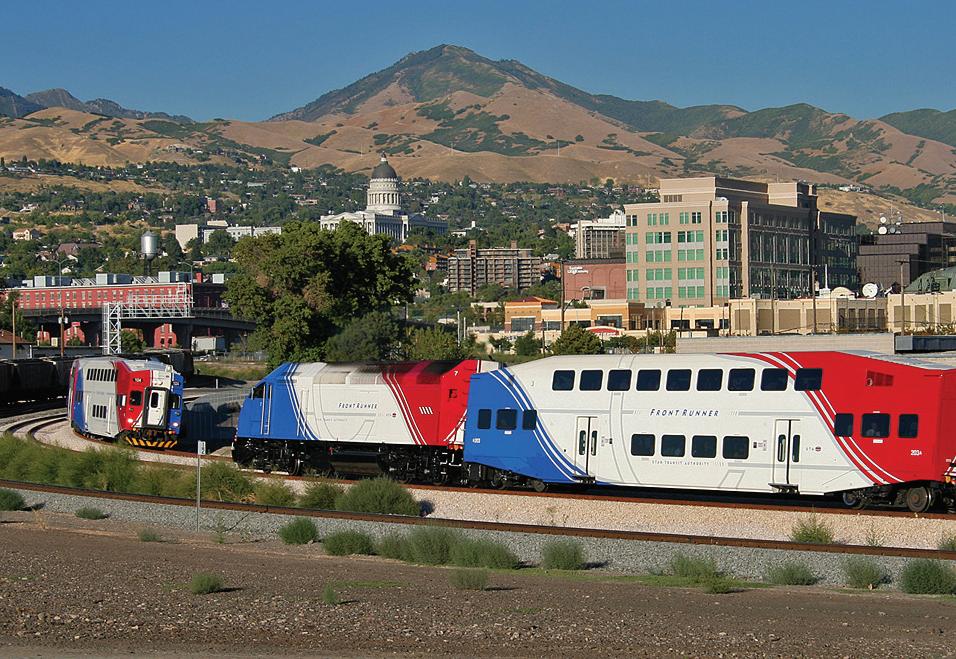


HiGHliGHTS
Education is a top priority for the administration of Utah Governor Gary herbert.
Utah has 10 public and three Utah-based private universities and colleges.
Utah research universities have been extremely effective at commercializing promising technologies.
The University of Utah ranked first in 2010 and 2011 for the number of start-ups powered by technology developed by faculty at a U.S. university.
Approximately 90 percent of Utahns have earned at least a high school degree.
The education and training of the nation’s youngest population carries both tremendous challenges and opportunities. Utah Governor Gary Herbert has made high-quality, relevant education for this dynamic, youthful workforce one of his administration’s highest priorities. In fact, Utah has the largest proportion of its population in the 5-17 school age group (22 percent) of any state, and plays host to the country’s largest pre-school population on a per-capita basis (9.5 percent). While these dynamics create the need for education and government leaders to devise innovative ways of providing education, it also provides the state with a workforce ready and able to fuel the growth of the state’s innovative companies.
To meet the needs of its established and growth companies, Utah is working diligently to expand and enhance its statewide educational system—which includes highly-regarded institutions of higher learning, together with a growing number of innovative workforce training, applied technology, career and vocational educational opportunities. In addition, a collaborative commission convened by Governor Herbert and consisting of key leaders ranging from education and government to industry is working to maximize the efficiency and quality of the state’s education system.
Utah consistently ranks among the nation’s leading states for the percentage of its population 25 years and older who earn high school diplomas and four-year degrees. In 2010, the most recent year for which national statistics were available, Utah ranked eighth in the percentage of persons with high school diplomas (90.4 percent) and 20th in the percentage of persons with a bachelor’s degree (28.5 percent).
Utah’s network of public and private K-12 schools offers high-quality primary and secondary education to students across the state. Diverse offerings in Utah’s schools include: adult education; special education and gifted and talented curricula; vocational courses of study, from agriculture to business marketing, entrepreneurship, applied technology, performing arts, economics and work-based learning; early graduation; and distanceand computer-based learning. In 2011, there were an estimated 591,089 students in Utah’s public education system, up 14,754 (2.8 percent) from

Source: IPEDS Completions Surveys - Does not include UCAT Data
2010, at approximately 900 community-based schools across the state. Student performance in Utah continues to rise. According to the Utah Board of Education, Utah’s students continue to score above the national average on standardized tests. In the Iowa Test of Basic Skills (ITBS), administered nationwide for grades 3, 5 and 8, Utah students in all three grades scored 8 percent above the national average. Utah high school students taking standardized tests such as the ACT, SAT and Advanced Placement tests consistently score considerably higher than the national average. In 2011, the pass rate for Utah students on AP exams was 68 percent (up 1 percent from 2010), compared with a 58 percent pass rate nationwide. Utah students taking the SAT college entrance exam achieved average scores of 563 on reading, 559 on math and 545 on writing—compared with national average of 497 on reading, 514 on math and 489 on writing. Utah continues to have the youngest population in the country, ranking first in the percent of the population under 18 (31.5%) in 2010.
In addition to public and private schools, Utah parents can opt to send their children to one of the state’s innovative charter schools. Charter schools are non-sectarian public schools that are open to all students at no cost, but are geared to a specific curriculum or area of special interest and preparation for the students. Some of Utah’s distinctive charter schools include science and technology high schools, schools for fine arts, performing arts, early college coursework and other areas. Tuacahn High School near St. George, for example, focuses on arts programs, while the curriculum at the Academy of Math, Engineering, and Science in Salt Lake and the Utah Academy of Math and Sciences in Orem focus on college preparation emphasizing math, sciences and technology.
The number of Utah charter schools has grown steadily since the program began in 2000 with eight schools and 390 students. As of March
1, 2012, 86 Utah charter schools educate approximately 45,000 students, accounting for approximately 8 percent of all Utah public-school students. For more information and a directory of the state’s current charter schools, visit http://schools.utah.gov/charterschools.
Utah’s 124 private and parochial schools provide quality educational options for the nearly 20,000 students attending these schools. (http://utah. educationbug.org/private-schools/) At approximately 3 percent, Utah has the lowest percentage of students in private schools in the nation.
h
Students pursuing higher education in Utah have a diverse and compelling set of colleges and universities at their disposal, including public and private institutions that cater to a broad variety of academic interests and career goals. Utah residents and visitors are served by five public community colleges—College of Eastern Utah (Price), Dixie State College (St. George), Salt Lake Community College (Salt Lake City), Snow College (Ephraim) and the new Utah College of Applied Technology (nine locations throughout the state)—and one private two-year college, LDS Business College (Salt Lake City).
A host of bachelor’s degrees are offered at three public universities— Southern Utah University (SUU; Cedar City), Utah Valley State University (UVSU; Orem), Weber State University (WSU; Ogden)—and one private college, Westminster College (Salt Lake City). In addition, SUU, WSU and Westminster offer select graduate programs.
Utah’s three major Ph.D.-level research universities—the University of Utah, Brigham Young University and Utah State University—have each distinguished themselves for their world-class research and
For example, the world’s first artificial heart transplant, the first
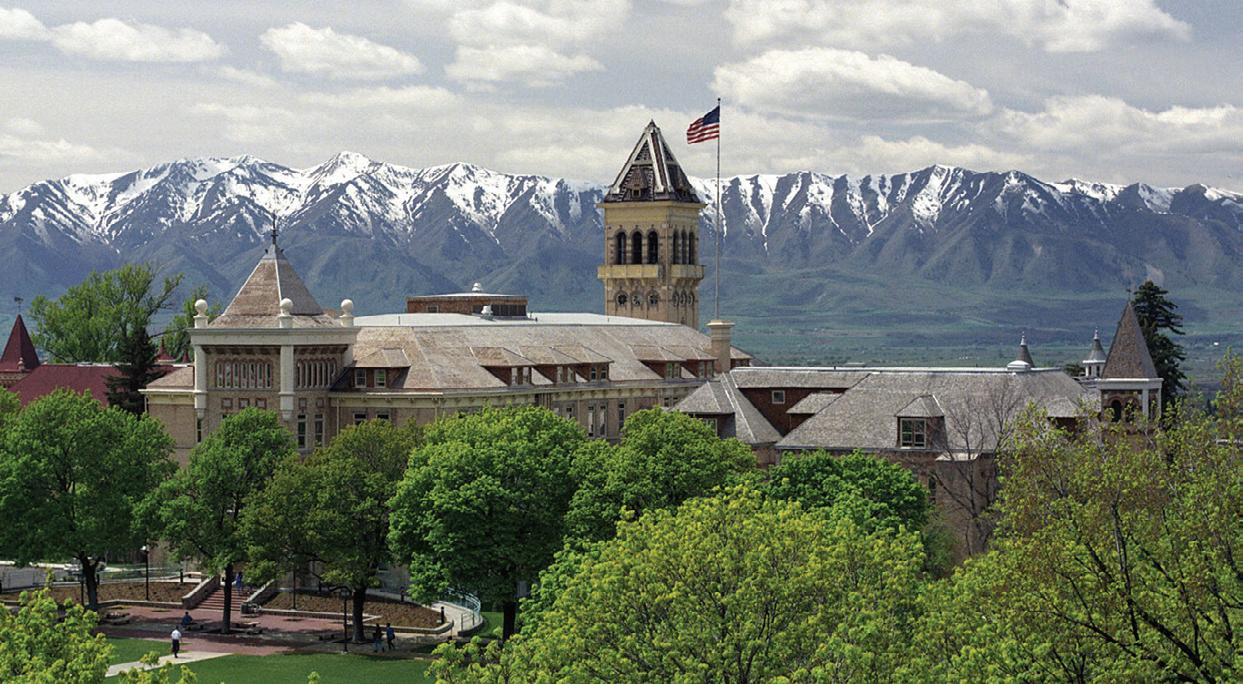
system for real-time heart monitoring, digital recording, computer graphics and word processing were all pioneered by faculty at Utah universities. Each of these universities is distinguished for their entrepreneurial strengths.
In 2011, Utah’s public institutions of higher learning enrolled a combined 174,013 students, a 1.66 percent increase over the 2010 enrollment figures, according to the Utah System of Higher Education. In addition, 33,000-plus students were enrolled at Brigham Young University, 1,855 at LDS Business College and approximately 3,200 at Westminster College. In the past two decades, enrollment in the Utah system of higher education has more than doubled.
Public Utah State Higher Education institutions in aggregate awarded 28,408 certificates and degrees in 2009-2010 (not including Utah College of Applied Technology awards). Liberal Arts and Sciences was the most
Source: Utah Systems of Higher Education
commonly-pursued field of study, with 5,940 students, followed by Health Professions (4,489), Business and Marketing (3,796), Social Sciences (2,102,) Education (1,922) and Engineering (1,301). The System awarded 12,867 bachelor’s degrees in the same time period, with the top fields of study being (in descending order) Business and Marketing, Liberal Arts and Sciences, Education and Social Sciences.
Consistent with Utah’s tradition of practical innovation in education, in 2001 the state created the Utah College of Applied Technology (UCAT) to deliver official Applied Technology Education (ATE) programs that range from basic skills training to professional certificates, with the potential to go on and earn associate degrees. These programs focus on the demands of the global
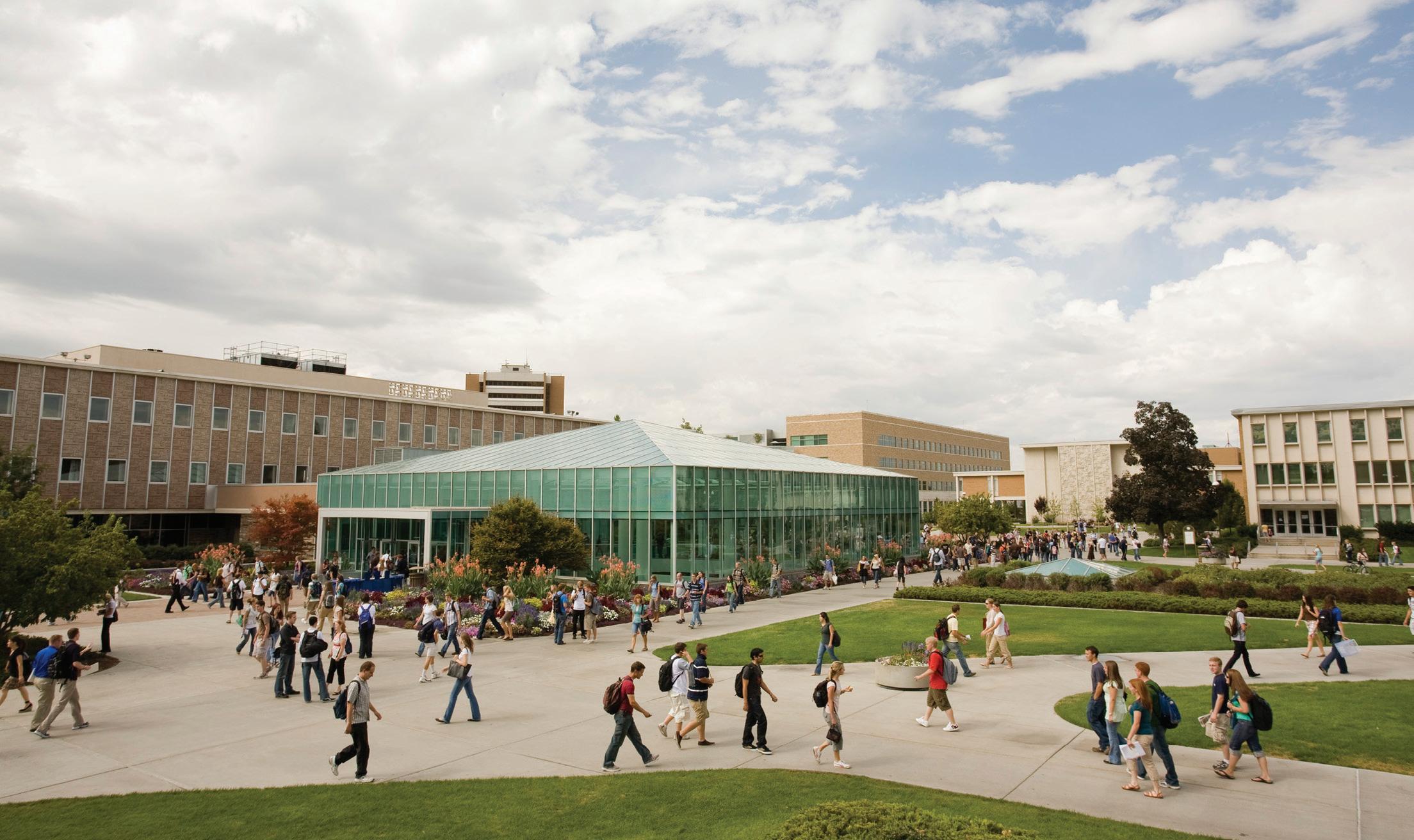
economy, providing students with applied skills for entry-level employment while helping them lay the foundation for the academic and advanced technical skills they will need for their lifelong career development.
The UCAT institutions work closely with hundreds of businesses in Utah to customize programs designed to meet companies’ workforce training needs and upgrade employees’ knowledge and skills. These include “Custom Fit Training” and “Short-term Intensive Training” (STIT), which provide training tailored to the performance of specific jobs at new or expanding companies; continuing education; the Salt Lake Community College Skills Center; and a variety of skills-based conferences, workshops and licensing programs. For more information about Custom Fit and Short-term Intensive Training programs in Utah, please visit www.ucat.edu/business/industry.
In FY 2011, the Utah College of Applied Technology (UCAT) enrolled approximately 56,000 college and high school students throughout the state, including more than 14,000 in the Custom Fit program. UCAT currently offers several hundred short- and long-term certificate training programs. UCAT offers programs for high school students and adults. In addition, eight Utah institutions of higher learning offer credit and non-credit Applied Technology Education programs. For details, visit www.ucat.edu.
Utah’s universities have strong long-term ties with the state’s business community. Utah is consistently one of the leading centers for entrepreneurship in the nation, due in large part to the influence of the state’s universities. Utah universities have created exceptional technologytransfer programs to help turn ideas and research into viable commercial prospects. In both 2010 and 2011, for example, the University of Utah generated more company spinoffs from home-grown technologies than any other U.S. university, after sharing top honors with MIT in 2009.
In addition, Utah’s renowned Centers of Excellence program, founded in 1986, provides funding and infrastructure to transform compelling university-related ideas into products and companies.
In the 2006 session, the Utah Legislature passed the Utah Science, Technology and Research (USTAR) initiative, which is fostering researchrelated economic development at Utah’s institutions of higher learning. USTAR attracts top research talent to the state’s research institutions and assists in R&D and commercialization.
For more information on technology commercialization programs in Utah, contact the technology commercialization offices at the University of Utah, Utah State University or Brigham Young University. For more information on Utah’s Centers of Excellence program, visitwww.goed.utah.gov/COE. For more information about USTAR, visit www.innovationutah.com
Utah is home to a number of distinctive professional colleges and Universities. Neumont University, located in South Jordan, provides accelerated applied technology education programs. Neumont offers 28-month Bachelor of Science degrees in computer science, software and game development, technology management, and web design and development, and a Master of Science in computer science. Students can also obtain optional IBM, Microsoft, Sun and other certifications during the course of their studies. Neumont’s hands-on, collaborative and project-driven approach helps graduates currently earn an average starting salary of approximately $60,000. Stevens-Henager College, founded in 1891 as a business college in Ogden, is an accredited private college that offers Bachelor’s and Occupational Associate’s degrees in healthcare, business, information technology and graphic arts. Stevens-Henager students can complete an Associate’s degree in 15 months and a Bachelor’s in 30 months, with day and evening classes
beginning each month. There are currently five Stevens-Henager campuses in Utah—Logan, Ogden, Provo/Orem, Salt Lake City and St. George—and two more in Idaho. There are also Utah satellite locations in Layton and Lehi and another in Nampa, Idaho.
Western Governors University (WGU), headquartered in Salt Lake City, is a private, non-profit online university founded by the governors of 19 Western states, and supported by numerous U.S. foundations and corporations. The only accredited university in the nation to offer competency-based, online degrees, WGU offers certification and Masters-level programs in teacher education and a variety of bachelors and/or masters degrees in business, healthcare and information technology. Currently, WGU leads the nation’s universities in the number of programs and students involved in online teacher certification, credential and licensure programs.
Other leading vocational/career college options in Utah include Argosy University, Devry University, Eagle Gate College, Everett College, the Keller Graduate School of Management, the Roseman University of Health Sciences, the University of Phoenix, TechSkills, Upper Limit Aviation, Utah Career College and the Utah College of Massage Therapy. Utah’s institutions of higher learning continue to be an irreplaceable source of learning and innovation, providing rich academic and professional resources for current and future generations of students to mine and leverage.
UTAH SCienCe
BiODEviCE anD BiOPharma
•Applied Nutrition, USU
•Biomedical Device Innovation, U of U
•Synthetic Biomanufacturing, USU
•Veterinary Diagnostics and Infectious Disease, USU
•Genomic Medicine, U of U
nanOTEChnOLOgy
•Wireless Nanosystems, U of U
•Nanotechnology Biosensors, U of U
•Micro and Nano Systems Integration, U of U
EnErgy
•Alternative Energy, U of U
•Energy Initiative, USU
•BioEnergy, USU
•Fossil Energy – Carbon Engineering, U of U
•Intuitive Buildings, USU
•Wireless Power Transfer, USU
mEDiCaL imaging anD Brain mEDiCinE
•Circuits of the Brain, U of U
•Diagnostic Neuroimaging, U of U
•Imaging Technology, U of U
•Nanoscale and Biomedical Photonic Imaging, U of U
viSUaLizaTiOn TEChnOLOgy
•Digital Media, U of U
•Advanced Sensing and Imaging, USU
•Space Weather, USU


Governor Gary herbert’s administration has developed a major strategic energy plan to address energy independence and economic development needs.
Utah’s electric power and natural gas rates are among the nation’s lowest.
Utah has the highest broadband participation rates of any U.S. state.
residents of Utah benefit from excellent telecommunications systems, including an extensive broadband network.
Utah is endowed with abundant natural gas resources.
Business and residential consumers in Utah enjoy some of the least expensive, most stable energy supplies in the nation, including energy from renewable sources. As one of the most connected and tech-savvy states in the union, Utah employs first-rate telecommunications capabilities that rank it at or near the top for connectedness, technology and penetration. Well-managed, generally abundant water sources ensure the continued growth and prosperity of the state’s citizens and businesses. Energy is also major driver of Utah’s economy. According to the Utah Energy Office, more than 23,000 Utahns earn more than $1.5 billion annually from the energy sector (www.energy.utah.gov).
Energy is a major priority for the administration of Utah Governor Gary Herbert. He continues to support the Utah Science Technology and Research (USTAR) program, a research and technology initiative built around the state’s world-class research institutions and focused on the development of Utah energy technology (www.innovationutah.com).
Governor Herbert and his administration have also created the Utah Energy Initiative, an ambitious 10-year strategic plan designed to responsibly develop the state’s abundant natural energy resources and tap its entrepreneurial talent to establish Utah at the forefront of solving the world’s energy challenges.
Additional information about Governor Herbert’s Utah Energy Initiative is available at www.utah.gov/governor/docs/10year-stragegic-energy.pdf.
In Utah, the Public Service Commission (PSC) regulates the rates and conditions of service for electric power and natural gas provided by investorowned utilities. Local governments regulate the state’s municipal power and water companies. The commission allows telecommunications prices to be determined by market forces in densely populated areas, but regulates the rates for intrastate telecommunications services provided by the local phone companies in rural areas. The PSC also regulates water companies in cases in which the customers are not also owners of the company, or the company is not a governmental entity. Most of Utah’s water users are served by approved municipal water systems governed by water boards in their respective municipalities. The commission is comprised of a chairman and two commissioners appointed by Utah’s governor and confirmed by the Utah Senate, each for six-year terms.
Aided by increasingly sophisticated technology and newly discovered natural resources in Central Utah and the Uintah Basin, Utah is in the midst of a surge in petroleum and natural gas production. According to the U.S. Department of Energy, Utah contains four of the nation’s 100 largest oil fields and two of its 100 largest natural gas fields.
Natural gas prices in Utah are among the lowest in the nation, aided by Utah’s abundant supply of natural gas. Historically, natural gas produced in Utah has been used for internal consumption, but in 2011, two interstate gas pipelines have been completed, linking Utah natural gas production facilities with other states.
As reported by the U.S. Department of Energy’s Energy Information Administration, pricing to Utah residential customers was $7.79 per thousand cubic feet in December 2011 for residential use, fifth lowest in the nation and well below the national average price of $9.69. Utah’s commercial price was $6.55, tied for second lowest in the nation, compared with the average national price of $8.28.
The principal supplier of natural gas in Utah is Questar Gas Company, which currently serves more than 850,000 customers in Utah and is the only operating natural gas utility regulated by the Utah PSC. Close to half of the natural gas currently used by Questar’s residential Utah customers is provided at cost-of-service pricing (Questar’s price of producing and transporting the gas) instead of market prices, because Utah’s residential rate payers have a legal right to purchase this gas at cost of service rates due to their ownership interest in some existing gas fields managed by Questar. The cost to develop and deliver this gas historically has been lower and more stable than the cost of gas purchased from either thirdparty suppliers or Questar’s parent company, Questar Inc. Utah’s growing population will require additional supplies of gas outside of the cost-ofservice agreements, pushing prices slightly higher in the future. However, it is anticipated that Utah citizens will continue to enjoy lower average rates than consumers in most other U.S. states.
Industrial electric rates in Utah’s major cities are consistently among the lowest of U.S. cities nationwide. A plentiful supply of low-cost energy has aided the state in avoiding the high prices and large spikes that have plagued many West Coast cities in recent years. According to the Utah Public Service Commission, between 85 and 90 percent of all electrical generation produced in Utah comes from clean burning coal, much of which is exported to other states.
Rocky Mountain Power (a division of PacifiCorp) is the largest electric utility in the state. Additionally, 41 municipalities in Utah provide electric power to their residents (publicutilities.utah.gov/map.html). Currently, 11 other retail providers of electricity are certified and regulated by the state’s Public Service Commission: nine rural cooperatives, one electric service district and one investor-owned utility. Rocky Mountain Power anticipates that sales growth in urban regions of Utah will rise by about 3.5 percent annually for 2012, and will grow for the foreseeable future.
According to the U.S. Department of Energy’s Energy Information Administration, in January 2012 Utah’s combined price for electricity, 6.48 cents per kilowatt hour, was second lowest in the U.S., compared with a national rate of 9.55. The state’s price for industrial electricity was 9.25 for residential electricity costs, 11th lowest in the U.S., compared with 11.43 nationally. For commercial, the rate was 7.35, sixth lowest among the states, compared with an average national rate of 9.88. At 5.11, the state’s industrial rate was the seventh lowest, compared with a national rate of 6.50. For more information, visit the U.S. Energy Information Administration at www.eia.com.
The state has undertaken a number of proactive projects to increase the energy generated by renewable sources. For information about Utah’s renewable energy programs, including federal and state incentives, visit the Utah Energy Office at www.energy.utah.gov/renewable_energy. Additional

information about a variety of renewable energy programs in Utah can be found at the website of the non-profit organization Utah Clean Energy, www.utahcleanenergy.org.
Notably, several major wind turbine facilities are now in operation in Utah. The two largest include:
• 18.9-megawatt Wind Park ii facility in Utah County.
• 307.5-megawatt milford Wind Corridor project in Millard and Beaver counties, which has the capacity to power approximately 65,000 homes annually with clean, renewable energy. The national award-winning facility exports energy to Southern California. Two additional planned phases will generate an estimated 600 megawatts of power annually.
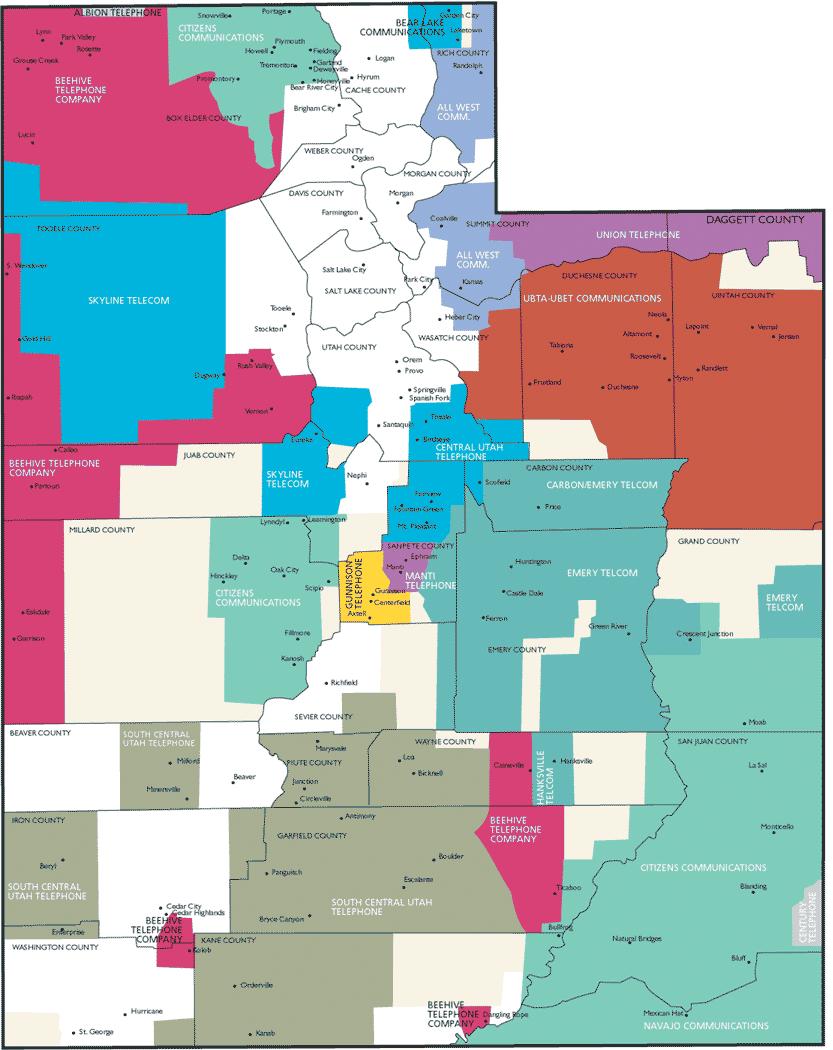

Manti Telephone Company
South Central Utah Telephone Association
UBTA, UBET Communications
1. meet the projected energy growth demands over the next decade by making balanced use of fossil fuels and alternatives and renewable resources in a market-driven, cost effective, and environmentally responsible way.
2. Ensure Utah’s continued economic development through access to our own clean and low-cost energy resources.
3. Develop the best new cutting-edge technologies, particularly those that enable us to utilize precious natural resources with an elevated environmental consciousness, and deploy them in Utah, the nation, and the world.
4. Create new and support existing energy related manufacturing opportunities and jobs in Utah.
5. modernize the regulatory environment to support sustainable power generation, energy transmission solutions and energy conservation.
6. Promote energy efficiency, conservation and peak consumption reductions.
7. facilitate the expansion of responsible development of Utah’s energy resources, including traditional, alternative and renewable sources.
8. Pursue opportunities for Utah to export fuels, electricity and technologies to regional and global markets.
9. Enhance and further integrate partnerships between industry, universities, state government and local communities—especially those in energy-rich rural communities-to address future energy challenges and opportunities.
10. Collaborate with other western regional states to present a strong and unified voice to federal regulatory agencies on energy and public land issues.
One crucial Utah natural resource is the high-quality groundwater available throughout most of the state. Virtually all of Utah’s municipal waterworks systems have access to springs and wells. Although Utah is located in an arid region, the mountain watershed areas, which feed the state’s natural and man-made storage systems, receive up to 60 inches of precipitation annually.
The yield from the Utah watershed, combined with yield from rivers flowing throughout the state, supply water to meet the needs of an expanding population and economy. Utah’s water is supplied to users by a number of improvement districts, water districts and local communities— most of which are not controlled by the Public Service Commission. For additional information, visit the Utah Division of Water Resources at http:// naturalresources.utah.gov/divisions/water-resources.html, and the Utah Public Service Commission at www.psc.utah.gov.
Utah is home to more than 50 unique communications companies providing cutting-edge services on both business and residential fronts. On the more “urban” Wasatch Front, a variety of providers service most areas, providing robust service and price competition. In the more “rural” areas of the state, independent telecom companies provide services that are upto-par and in some cases better than their more-urban counterparts. One reason Utah is so well connected is because of the unique system of publicprivate partnerships and trade agreements formed through efforts led by the Utah Department of Transportation and the Utah Education Network. Utah has become the fiber optics hub in the Western United States, because of its numerous Internet backbone connection points. Utah communications companies continue to invest in the state in order to offer
the latest voice, data and wireless services. For example, the two largest communications service providers in the state, CenturyLink and Comcast, have invested more than $1 billion building Utah telecommunications infrastructure over the past decade. Other prominent providers, such as AT&T, Verizon, CentraCom Interactive, Strata, and new-comer, Syringa have also made significant investments in building out and upgrading their networks.
Many private providers and state-led broadband efforts have recently been bolstered by federal grants to fund major broadband build-outs to previously underserved cities, schools, and tribal lands in the State. One prominent example is the Utah Telecommunication Open Infrastructure Agency (UTOPIA). UTOPIA is one of the nation’s largest fiber optic networks and consists of 16 Utah communities that have joined to offer high- bandwidth services to their residents and businesses.
Utah rural telecom companies have been proactive in providing advanced technology services to the rural areas they serve. According to a 2011 survey conducted by Utah State Univserity, no urban/rural gap exists in demand for broadband services in the state. This finding is particularly significant considering the common notion that rural demand for broadband services is normally much lower than urban demand for such services. For more information about Utah’s telecommunications industry and providers, visit the PSC’s website at www.psc.utah.gov or the Utah Broadband Project at www.utah.gov/broadband.
The Utah Broadband Project, a joint effort between the Governor’s Office of Economic Development, the Public Service Commission, and the Department of Technology Services’ Automated Geographic Reference Center, has created an interactive map of available broadband services, and is developing a plan to increase broadband adoption and deployment throughout Utah, working with the Utah Broadband Advisory Council. According to a recent study, complied using 2010 Census data, 80 percent of the state’s residents use broadband, ranking Utah number one in the nation. Utah was also ranked number four in the nation for broadband speeds, earning the top ranking of all western states. For additional information, visit http://utah.gov/broadband.
Utah is at the forefront of efforts to ensure that all citizens have access to high-quality telecommunications services. Legislation passed in 2007 makes relay services and equipment available to those with hearing loss and other disabilities. This includes distribution of assistive telecommunication devices such as amplified telephones, captioned telephones and text telephones to people who meet the program’s financial guidelines. As a result of new technology developments, the choices continue to expand for people unable to use a standard telephone. The communications market now includes Video Relay Services (VRS), Internet Protocol Relay (IP Relay), captioned telephones in addition to the improvements to equipment such as amplified telephones and text telephones. Equipment manufacturers including global VRS leader, Utah-based Sorenson Communications, have improved picture quality, amplification and sound quality for hardof- hearing users, and added such features as captions for the deaf. For additional information about relay services for the deaf and hard of hearing, visit the Utah Public Service Commission at www.psc.utah.gov.


Utah’s average household size, 3.10 persons, is the largest in the U.S.
Utah’s fertility rate of 2.60 per woman ranks first nationally.
Utah’s median age of 29.2 is the youngest in the U.S.
Utah ranks first nationally in percentage of family households (71.4 percent) and married couple families (60.5 percent).
Approximately 75 percent of Utah’s populace lives in Salt lake, Utah, Davis and Weber counties.
Utah’s population growth continued to soar in 2011. The Beehive State holds the nation’s highest fertility and birth rates, highest life expectancy rate and, for the 21st consecutive year, leads the nation’s net in-migration. Following a sustained period of precipitous growth, Utah’s 2011 total population stood at an estimated 2,817,222. The state’s 1.9-percent population growth, though considerably lower than the record 2007 level of 3.2 percent, was still the third-highest in the U.S., behind only the District of Columbia (2.7 percent) and Texas (2.1 percent).
The Governor’s Office of Planning and Budget projects that natural increase (number of births less number of deaths) will add 39,000 people to Utah’s population in 2012, while net in-migration will bring 5,000 more residents to the state.
After experiencing annual population growth of 2.7 percent in the decade beginning in 2000, the U.S. Census anticipates sustained growth in Utah to continue in future decades. The state’s population is projected to reach 3.7 million in 2020, 4.4 million in 2030, and 6.8 million in 2060. The projected growth rate of 1.3 percent, though still lower than that of the past decade, is twice the projected national rate.
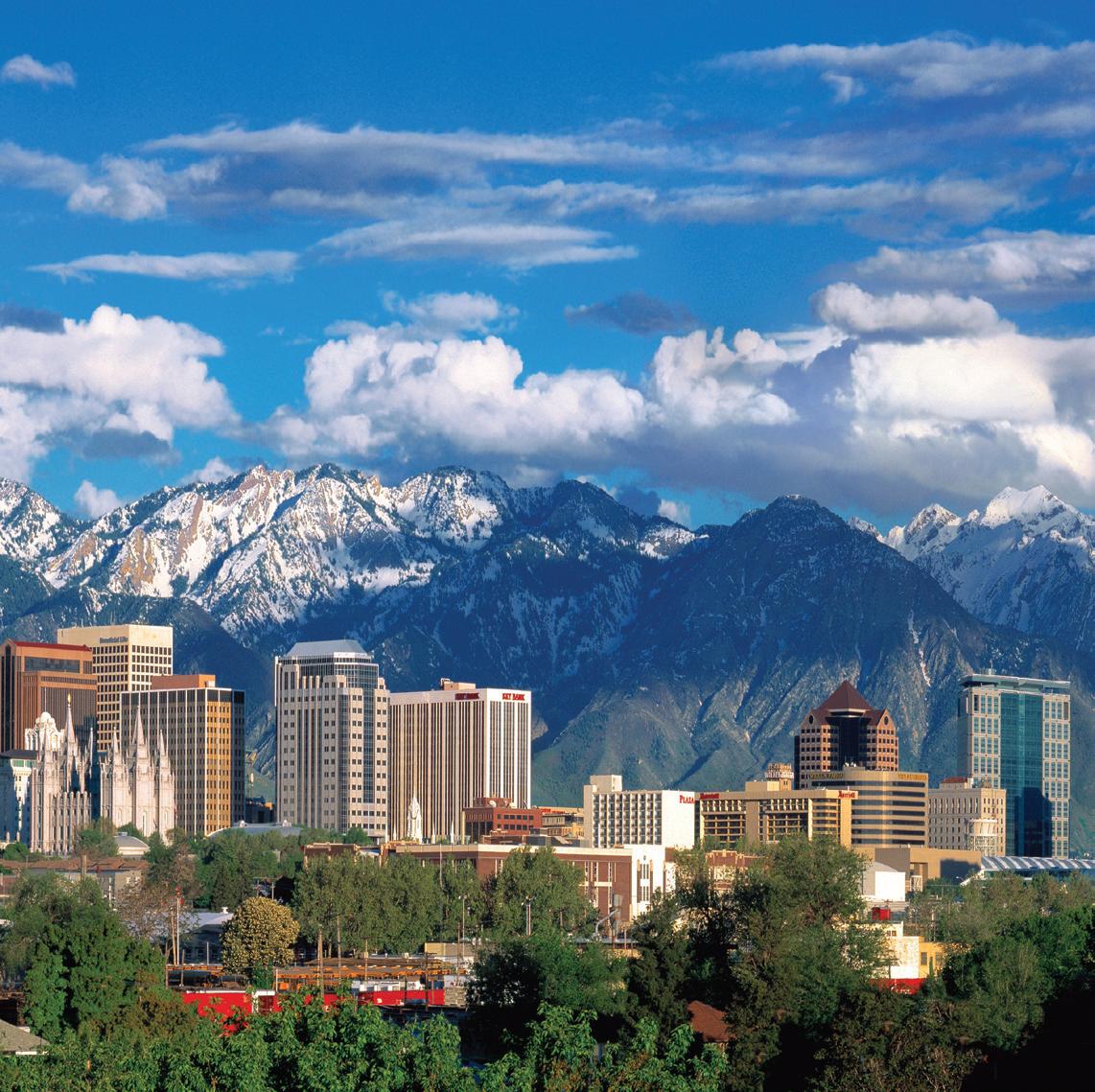

•Population of 2,763,885, up 23.8 percent from 2000 (compared to 9.7 percent growth nationwide)
•9.5 percent of Utah’s population under 5 years old (nation: 6.5 percent)
•31.5 percent of Utahns under 18 years old (nation: 24 percent)
•Females 49.8 percent (nation: 50.8 percent)
•White persons (census descriptions): 86.1 percent (nation: 72.4 percent)
•Black persons: 1.1 percent (nation: 12.6 percent)
•Asian persons: 2.0 percent (nation: 4.8 percent)
•American Indian or Alaskan native: 1.2 percent (nation: 0.9 percent)
•Native Hawaiian/Pacific Islander: 0.9 percent (nation: 0.2 percent)
•Hispanic or Latino origin: 13.0 percent (nation: 16.3 percent)
Source: U.S. Census Bureau
Source: U.S. Census Bureau
Source: Governor’s
Am ERICA’S mOST yO u T hfu L STATE
Utah’s unique age structure contributes to the state’s energetic, productive lifestyle.
According to the U.S. Census Bureau, Utah ranks as the youngest state in the nation, with a median age of 29.2—a major factor in the state’s longterm economic viability, together with its smart workforce, excellence in higher education and perennially strong economic and fiscal performance. The fertility rate in Utah—an average of 2.6 per Utah woman—is the highest of any U.S. state. Utah ranks first in the percentage of its population that is pre-school age (9.5 percent), and within the K-12 ages of 5 to 17 (22.0 percent). Conversely, the state has the smallest per-capita workingage (18-64) population (59.5 percent) and the second-smallest retirementage population (9.0 percent).
Utah continues to have the largest household size in the country, with 3.10 persons per household. Utah also ranks first nationally in percentage of family households (71.4 percent) and married couple families (60.5 percent).
Utah’s population continues to diversify, with peoples from many nations and cultures drawn to the quality of life and the vibrant entrepreneurial environment the state fosters. Growth in the state’s Hispanic population is particularly strong. Hispanics now make up 13 percent of Utah’s population—a 78 percent increase over the 2000 count by the U.S. Census Bureau. The number and revenue growth of Hispanic-owned businesses in Utah are consistently among the fastest in the nation.
Utah’s White (including Hispanic) population equal’s 92.9 percent of the state’s total population, but the state is home to a diverse populace, including Asian, 2.0 percent; American Indian and Alaska Native, 1.4 percent, Black or African American, 1.3 percent; and Native Hawaiian or Other Pacific Islander, 0.8 percent, according to the Census Bureau.
According to the 2010 Census (the most recent available for city data), Salt Lake City remains the state’s largest city with a population of 186,440, followed by West Valley City with 129,480 residents; Provo with 112,488; fast-growing West Jordan at 103,712; Orem, at 88,328 residents, rounds out five largest cities. The Beehive State’s next five largest communities are Sandy, 87,461; Ogden, 82,825; St. George, 72,897; Layton, 67,311; and Taylorsville, 58,652.
The vast majority (nearly 75 percent) of Utah’s population is still heavily clustered in four urban counties at the base of the Wasatch Mountains: Salt Lake, 1,029,655 residents in 2010; Utah, 516,564; Davis, 306,479; and Weber, 231,236. Utah’s fifth-most-populous county is Washington County in the southwestern corner of the state, with 138,115 residents.
Utah’s fastest-growing cities, clustered along the Wasatch Front and Washington County, are led by Saratoga Springs, with its meteoric 1,672.8-percent growth rate from 2000-2010; and Herriman, at 1,330.4 percent. These two outliers are followed by Eagle Mountain, 892.8 percent; Cedar Hills, 216.6 percent; Syracuse, 158.9 percent; West Haven, 158.4 percent; Lehi, 149.1 percent; Washington, 129.2 percent; Highland, 90.0 percent; and Santaquin, 88.8 percent.
The five fastest-growing counties during this same period were mountainous Wasatch County, on the Wasatch Back, at 54.7 percent; Washington County, in Utah’s southwestern red rock country, 52.9 percent; Tooele County in the northwestern part of the state, 42.9 percent; Utah County, 40.2 percent; and Iron County in southwestern Utah, 36.2 percent.


Utah combines excellent economic opportunity with a cost of living well below that of other strong economic locales.
Utah is home to five national parks, seven national monuments, two national recreation areas and six national forests.
Utah has 14 world-class ski resorts, 10 within a one-hour drive from Salt lake International Airport.
No place offers its citizens and visitors a more compelling quality-of-life package than Utah does. Safe, affordable cities, towns and neighborhoods coexist with breathtaking scenery and economic dynamism
The most entrepreneurial state in the U.S. is also the best-governed and best-positioned for long-term economic recovery and sustainability. Among a host of accolades, the Beehive State garnered the top spot for “Expected Economic Recovery” and “Economic Outlook” from the American Legislative Exchange Council’s 2011 State Economic Competitive Index, while taking top honors on the Forbes list of “The Best Places for Business and Careers” for two consecutive years.
Utah’s exceptional economic performance is bolstered by a state government that is continually recognized for fiscal discipline and governing moxie. (See GOVERNMENT chapter in this book for more information.) In a time of persistent economic challenge, Utah continues to shine as a financially sound, stable and dynamic environment for innovation, growth and opportunity.
Utah consistently ranks high on many measures that indicate the overall well-being of its people. Utahns enjoy a high standard of living in safe, vibrant and affordable communities. In the national Gallup Healthways Well-Being Index, Utah is perennially among the top five states for the happiest populace. While Utah’s median household income ranks eighth nationally (U.S. Census Bureau 2008-2010), Utah communities are also exceptionally affordable from a cost-of-living standpoint. According to Kiplinger’s Best Value Cities 2011, money goes further in Salt Lake City than it does in other major metropolitan areas. The overall cost of living in Salt Lake City (95 percent of the national average) compares favorably with Las Vegas (101 percent), Denver (106), Portland (111), Minneapolis-St. Paul (112), Seattle (120 percent), San Diego (131) and San Francisco (161). Other wellness indicators emphasize Utah’s security, health, vitality and youthfulness,
The state’s residents also enjoy exceptionally strong health. According to the United Health Foundation State Health rankings, Utah was the seventh healthiest state in the U.S. for 2011, with the lowest rates of cancer death, smoking and income disparity. (See Healthcare chapter in this volume for additional information.)
Utah and its communities are among the nation’s safest. According to the CQ Press Annual State Crime Ranking, four Utah cities rank among the 100 safest (population of 75,000 or more) in the country: Orem (11), St. George (19), Sandy (69) and West Jordan (82).
Utah’s vitality is reinforced by virtue of having the nation’s youngest population and one of the fastest growing. According to U.S. Census Bureau data for 2008, the state’s median age is 29.2, lowest in the nation, while the population growth rate of 1.9 percent in 2011 was the second fastest. Utah also has the second-lowest percentage of the population age 65 and over (9.0 percent). (See Population section in this book for more information.)
Like the state’s spectacular scenery, Utah’s four-season climate provides dramatic contrasts, stimulating and refreshing the senses of hikers, bikers, skiers, photographers and everyone else. The state’s elevation ranges from a low of 2,200 feet in southwestern Washington County to more than 13,500 feet in the dramatic peaks of the Uinta Mountains. The average maximum daytime temperature in Utah’s metropolitan centers ranges from an average of approximately 37 degrees (36 degrees in Salt Lake City; 32 in Park City; 53 in St. George) in January to 93 degrees in July (92 degrees in Salt Lake City; 82 in Park City; 102 in St. George).
Utah’s climate features low humidity and plentiful sunshine. In Salt Lake County and many other areas in the state, the summer daytime relative humidity averages less than 30 percent, and sunny skies prevail most of the time. Annual precipitation varies from less than five inches in Utah’s arid Great Salt Lake Desert to more than 60 inches in the northern mountain ranges.
Utah’s incomparable attractions and experiences are reaching an increasing number of people throughout the world. In 2011, an estimated 20.2 million people visited the Beehive State, and tourism revenue rose to $6.525 billion, an increase of 4.7 percent.
In the winter, Utah’s 14 ski resorts provide some of the world’s finest skiing and snowboarding. In the 2011 issue of Ski magazine, voters and readers selected Utah’s Deer Valley resort as North America’s top overall ski resort for the fourth consecutive year. Park City Resort was named the “Number One Family Destination” by editors of Ski, as well as the sixth-ranked resort. Forbes named Snowbird and Alta the second-best U.S. ski resort. The Canyons, Solitude, Snow Basin and Brian Head are also perennial favorites. Low humidity and low mountain temperatures result in the dry powder snow for which Utah has become world famous, earning the moniker “The Greatest Snow on Earth®.” The heavy snowfall (up to 600 inches annually at some resorts) often extends the Utah ski season from November into May. For more information, visit www.skiutah.com and www.visitutah.com.
There are also plentiful opportunities for snowshoeing, ice climbing and snowmobiling on 850 miles of groomed trails running through fascinating and spectacular topography that ranges from rugged mountains to redrock deserts.
Winter sports enthusiasts treasure the Olympic legacy of the 2002 Salt Lake City Winter Olympic Games. Eleven venues housed the Olympics’ athletic events, including a best-in-class skating rink and one of the world´s fastest luge tracks. All of the Olympic venues—in Salt Lake City, Ogden, Provo, Park City and West Valley City—are open to the public, enticing visitors to personally experience the magic of the Games.


beST vAlUe CiTieS 2011 (overAll CoST oF livinG)
CITy nATIOnAL AvERAgE
Salt Lake City 95%
Las Vegas 101%
Denver 106%
Portland 111%
Minneapolis-St. Paul 112%
Seattle 120%
San Diego 131%
San Francisco 161%
Source: Kiplinger’s Best Value Cities
Utah’s outdoors offer enough adventure to fill many lifetimes of summer recreation, including camping, hiking, mountain biking, ATV riding, rock climbing, fishing, hunting and countless other activities in some of the most varied and spectacular scenery on earth. The state is also a global destination for water sports enthusiasts seeking adventure in whitewater rafting, kayaking, boating, jet skiing and scuba diving. Road trip fans flock to the state’s spectacular backcountry, including Utah’s All-American Road Highway 12, one of the world’s most scenic highways by any standard.
Utah’s mountains and redrock deserts enchant mountain bikers and touring cyclists of every level of ability. Moab is the quintessential U.S. cycling hub, and most of Utah’s ski resorts offer bike rentals as well as numerous mountain trails. For more information, visit Bicycle Utah at www.cyclingutah.com. Utah trails lead hikers into one-of-a-kind experiences in environments of endless
ogden raptors—Minor League Baseball, A Affiliate of the Los Angeles Dodgers
orem owlz Minor League Baseball, A Affiliate of the Los Angeles Angels of Anaheim
real Salt lake—Professional Soccer, Major League Soccer
Salt lake Bees Minor League Baseball, AAA Affiliate of the Los Angeles Angels of Anaheim
Utah Blaze—Arena Football, Arena Football League
Utah Blitzz Professional Soccer, Professional Soccer League
Utah Grizzlies—Professional Hockey, East Coast Hockey League
Utah Jazz—Professional Basketball, National Basketball Association
Utah Salt ratz—Professional Soccer, Men’s Premier Soccer League
Utah Snowbears—Professional Basketball, American Basketball Association
Utah Spiders—Professional Soccer, Women’s Premier Soccer League

variety. Many trails offer exotic experiences in close proximity to the state’s population centers; others promise remote wilderness far off the beaten path. For more information about hiking in Utah, visit www.visitutah.com. Utah offroad trails, including the Utah section of the Great American Trail, provide quick and easy access to walking, biking, hiking, horseback or ATV riding in spectacular settings. For more information, visit www.visitutah.com.
nATIO n AL PAR kS , mO num E n TS A n D R ECREATIO n A REAS
Southern Utah contains the greatest concentration of national parks in the United States. The state’s five national parks—Arches, Bryce Canyon, Canyonlands, Capitol Reef and Zion—are recognized as among the most spectacular and beloved national parks by visitors in the United States and from around the globe. In addition, Utah’s seven national monuments, two national recreation areas, one national historic site, and many state parks and recreation areas provide outdoor enthusiasts with unique and varied opportunities. The state’s national parks attracted 6.3 million visitors in 2011, including 2,825,505 for Zions National Park, while Utah’s 43 state parks attracted more than 4.8 million visitors. For more information, contact the Utah Office of Tourism (801) 538-1900 or visit www.visitutah.com.
Utah offers a wealth of artistic and cultural resources. The Utah Arts Council, founded in 1899, represents almost 200 theatres, more than 100 dance and approximately 500 music organizations, including the renowned Utah Symphony, Utah Opera, Ballet West and the Festival Opera Company. Utah is also home to a number of distinguished festivals and other cultural organizations and events throughout the state, including the pioneering Sundance Film Festival, the Tony Award-winning Utah Shakespearean Festival and the Mormon Tabernacle Choir. In addition, a major 2011 survey conducted by the National Tour Association, Salt Lake City was named the top faith-based U.S. tourist destination, tied with Israel for first in the world. For more information about Utah’s cultural offerings, visit www. nowplayingutah.com or www.visitutah.com.

1. Ballet West
Ballet West is one of America’s leading ballet companies. www.balletwest.org
2. n atural h istory m useum
Take advantage of the beautiful new Natural History Museum of Utah. With fascinating artifacts, dinosaurs and science displays and activities, the museum will please guests of all ages. www.nhmu.utah.edu
3. Timpanogos Cave n ational m onument
High in the Wasatch Mountains, the Timpanogos cave system consists of three spectacularly decorated caverns. Enjoy a hike with great views of American Fork Canyon on the way to the cave entrance. www.nps.gov/tica
4. Temple Square
Check out the capital’s most iconic building—the Salt Lake Temple. Guests to Temple Square can tour the surrounding buildings and gardens, as well as learn a bit about Utah history at the Beehive House. www.visittemplesquare.com
5. Clark Planetarium
Enjoy night sky tours, 3D movies or light shows set to music in the theaters. The planetarium also has many free science and space exhibits. www.clarkplanetarium.org
6. Antelope Island
Antelope Island is the largest island in the Great Salt Lake, and provides visitors with a variety of activities. The island is open to camping, and rails are available for hiking, biking and horseback riding. The island also houses a variety of wildlife, including the namesake antelope.
http://stateparks.utah.gov/parks/antelope-island
7. Arches n ational Park
Go camping and hiking among more than 2,000 natural sandstone arches. The 119 square-mile park’s major attractions are available via a 48-mile paved road, while other arches are accessible via hiking trails. www.nps.gov/arch
8. Sports g ames
Utah is home to many great sports teams. Take the whole group to a game or show of one of the pro, semi-pro or university teams in the area. The most well-known teams are the Utah Jazz, Real Salt Lake and the Salt Lake Bees.
9. m iller m otorsports Park
Miller Motorsports Park is a state-of-the-art road racing facility for automobiles, motorcycles and karts. The park hosts many racing events and is home to a performance driving and motorcycle school. www.millermotorsportspark.com
10. u tah’s h ogle Zoo
The zoo covers 42 acres and is home to nearly 900 animals. Visit the rare cats of Asian Highlands or check out the Elephant Encounter. www.hoglezoo.org
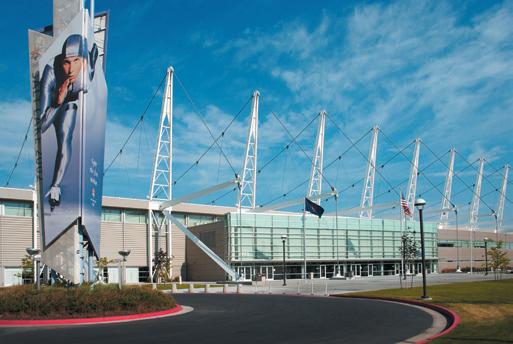
Utah Olympic Oval
5662 South 4800 West (Cougar Lane) Kearns, Utah
Speed Skating
Salt lake Ice Center/ EnergySolutions Arena
301 W. South Temple Salt Lake City, Utah
Figure Skating, Short Track Skating
E Center
3200 S. Decker Lake Dr. West Valley City, Utah
Ice Hockey
The Peaks Ice Arena
100 No. Seven Peaks Blvd. Provo, Utah Ice Hockey
Ice Sheet at Ogden 4390 Harrison Blvd. Ogden, Utah Curling
Park City mountain resort 1310 Lowell Avenue Park City, Utah
Giant Slalom, Snowboarding Parallel and Halfpipe
Deer valley mountain resort
2250 Deer Valley Drive
Park City, Utah
Slalom, Freestyle Aerials and Freestyle Moguls
Utah Olympic Park Olympic Parkway and Highway 224 at Kimball Junction
Park City
Bobsleigh, Luge, Skeleton, Ski Jumping and Nordic Combined
Soldier hollow (Wasatch State Park) 2002 Soldier Hollow Drive near Midway Biathlon, Cross-Country Skiing
Snowbasin Ski resort Highway 167 (Trapper’s Loop) (801) 399-0304
Downhill, Super G, Combined Downhill/Slalom
rice Eccles Olympic Stadium
University of Utah Campus
Salt Lake City
Opening and Closing Ceremonies, Home of Olympic Cauldron
Olympic village
University of Utah Campus
Salt Lake City
Athlete Village


Utah has a profound legacy of public-private collaboration to foster innovation and economic development.
Utah consistently recognized as the nation’s bestmanaged state with the most dynamic economy:
#1 “Best States for Business and Careers” from Forbes.
#1 “Debt weight Scorecard” from Forbes.
“the Best Managed State in the nation” by most recent Pew Center on the States study.
#1 for “economic outlook” from the AlEC -laffer State Economic Competitive Index.
#1 for “expected economic recovery” for the fourth consecutive year from the American legislative Exchange Council.
aaa bond/credit rating from moody’s, fitch and Standard & Poor’s.
UTAH GOVERNOR GARY R. HERBERT and his administration have successfully built an extraordinary public-private collaboration that has made Utah the nation’s most dynamic economy. Consistently ranking at the top of the best-managed U.S. states, Utah continues to garner awards and recognition, including:
• #1 “Best States for Business and Careers” from Forbes 2010 and 2011
• #1 for “economic outlook” from the ALEC-Laffer State Economic Competitive Index 2011 (fourth consecutive year)
• #1 for “expected economic recovery” from the American Legislative Exchange Council
• aaa bond/credit rating from Moody’s and Standard & Poor’s
• #1 “Debt weight Scorecard” from Forbes
• From the most recent Kaufman New Economy Survey (2010) Utah earned these high ratings #1 “Most Dynamic economy” #1 for “inventor patents,” #1 for “online population,” #1 for “e-Government”
The Pew Center study, a broad-based assessment of how a state manages people, information, infrastructure and capital, has recognized Utah’s ongoing commitment to sound economic growth. The study reports: “Utah has been a clear leader in sound government based on smart planning and effective performance management that emphasizes longterm results.”
In addition to garnering numerous No. 1 accolades for Utah from credible sources, the consistent rigorous governance of the state’s elected officials and regulators has helped position Utah for increased prominence in the global economy that emerges from the current global economic downturn. Pollina’s “Corporate Top 10 Pro-Business States for 2011: Rebuilding America’s Economic Power” ranks Utah second nationally for its enlightened pro-business policies.
Utah’s record of economic dynamism extends throughout the State’s cities and counties. In 2011, The Milken Institute ranked three of Utah’s cities among the nation’s best locations for business. Utah’s capitol, Salt Lake City, ranked No. 6. The institute ranked Provo No. 9 and Ogden No. 15. Among the nation’s small cities, Utah’s Logan ranked No. 1.
In addition, the State was named the most tech-savvy state in the nation by the 2008 and 2010 Digital States Survey, a comprehensive biannual survey performed by the Center for Digital Government. The study engaged the efforts of state chief information officers and senior executives from throughout the nation in analyzing information and services provided to citizens in areas ranging from technology infrastructure to online applications and new Web 2.0 technologies, and the nation’s first measurement of sustainability (emphasizing “green IT”) efforts.
Utah’s exceptional governance draws its vitality from a strong tradition of innovative economic development legislation and programs, developed through collaboration between the state’s public and private sectors and its higher education community.
Under the direction of Governor Herbert, the Governor’s Office of Economic Development is building upon this heritage through a bold yet sound approach to economic development that includes innovative business development programs and initiatives in the state. These programs—which are informed by the Herbert Administration’s top priorities of energy, education and high technology—include Technology Commercialization & Innovation Program, the Utah Fund of Funds, the Utah Economic Clusters and the Utah Science Technology and Research (USTAR) initiative, and other statewide and regional efforts.
One of the most remarkable and enduring Utah economic development victories began during the 1980s and 1990s. Utah regulators and legislators worked closely with leaders in the state’s banking sector to develop rigorous laws and policies that helped establish Utah as the clear global leader for special-purpose industrial banks (also known as industrial loan companies, or ILCs) for companies in a broad array of industries. For more information on Utah’s industrial banking industry and other financial services categories, visit the Utah Department of Financial Institutions website, www.dfi.utah.gov.
The Technology Commercialization & Innovation Program (TCIP) is a State-funded grant program developed by the Utah Legislature in 1986. TCIP was developed to help accelerate the process of taking universitydeveloped cutting-edge technologies to market, thereby driving economic development and creating jobs for Utahns. Many successful companies and products have developed as a result of TCIP. Funding has been provided to companies ranging from established industry players such as Myriad Genetics, Sonic Innovations and Moxtek to such promising young ventures as LineaGen, TechniScan Medical Systems and Larada Sciences.
The program’s companies in aggregate have entered into several hundred licensing agreements and obtained well over 200 patents. The TCIP program has resulted in the creation of approximately 220 companies; more than 70 are still active, employing 2,000-plus with an average salary of $65,000. In 2010-2011, the program received 45 proposals, of which 21 have received funding approval: 15 from the University of Utah, and five each from Brigham Young University and Utah State University. In recent years, TCIP has added refinements to accelerate the commercialization of university technologies and build a dynamic pipeline of products and companies by licensing promising university technologies to existing companies.
Through GOED, the Herbert Administration has strategically identified and developed seven economic clusters: Aviation & Aerospace, Defense & Homeland Security, Energy & Natural Resources, Financial Services, Life Sciences, Outdoor Products & Recreation, Software Development & Information Technology. The Economic Clusters Initiative serves as a catalyst to focus people, ideas and resources in Utah’s areas of greatest strength and potential in order to create high-paying jobs and economic development. Businesses within the clusters are supported through the establishment of synergies, improvement of distribution channels, creation and leveraging of economies of scale, and a highly skilled workforce. For more information, visit www.business.utah.gov/targeted-industries.
The Governor’s International Trade and Diplomacy Office assists Utah companies in developing markets for their products and services in foreign countries. The office has launched a series of national and international exchanges, designed to develop and strengthen personal and business relationships between business and government leaders in Utah and in other U.S. markets and abroad, and is currently engaged in developing an active Utah World Trade Center. The Kauffman Foundation ranked Utah #6 for “Export Focus of Manufacturing and Services” in 2010. Utah’s global exports reached nearly $19 billion in 2011, a 39.5 percent increase from 2010 to 2011. The State also leads the nation in five-year export growth. For more information, visit www.international.utah.gov.


The Utah Fund of Funds program was established with the passage of Utah House Bill 240 (“The Venture Capital Enhancement Act”) through $100 million of contingent tax credits. The Fund of Funds invests in strong performing venture capital/private equity firms, which in turn explore investments in promising Utah companies. In 2008, the Utah Legislature, with support and direction from the state’s entrepreneurial economy, voted to add $200 million in further contingent tax credits, bringing the total under the program’s management to $300 million. The program receives oversight from two boards: the public Utah Capital Investment Board (UCIB) and the private, executive Utah Capital Investment Corporation (UCIC). Over 500 Utah companies have been reviewed by Utah Fund of Funds portfolio managers, and 52 Utah companies have raised over $1.1 billion from the program’s funds. The Utah Fund of Funds program has played a key role in helping Utah rank #3 for “Fastest Growing Firms” and #5 for “Venture Capital” in the 2010 Kauffman Foundation study. For more information on the Utah Fund of Funds, visit www.utahfof.com.
During the 2006 Utah legislative session, strong collaboration between industry, government and education leaders resulted in passage of the Utah Science Technology and Research (USTAR) economic development initiative, which is designed to maximize research-oriented technology development and commercialization from Utah’s leading institutions of higher learning by attracting and developing top research teams throughout the world. USTAR’s focus ranges from biomedical to advanced nutrition, nanotechnology biosensors, biofuels, fossil energy and other efforts that leverage existing university and industry strengths, while addressing large, strategic markets and vast commercialization opportunities. USTAR has been instrumental in helping attract top research teams from throughout the U.S. to Utah. The Kauffman Foundation ranked Utah #11 for “High Tech Jobs” and #13 for “Scientists and Engineers” in 2010. For more information on USTAR, visit www.innovationutah.com.
To further accelerate job creation and economic development throughout the state, Utah leaders have established an array of incentive programs that target companies in key strategic industries for the state. All of these programs operate on a post-performance basis in order to spur company performance while assuring a positive ROI for Utah and its citizens. The Economic Development Tax Increment Financing (EDTIF) incentive was created to incent indigenous companies expanding in Utah, or companies outside the state relocating or developing new operations in the state to create high-paying jobs in Utah. The incentive generally runs 5-10 years, with a tax credit of up to 30 percent for the entire project. It is anticipated that these incentives will generate thousands of jobs, billions of dollars in new salaries and several hundred million dollars in state tax revenue annually.
The Utah Legislature and the Herbert Administration support the development of the state’s vibrant tourism and film industries, extending the reach of the state’s highly successful “Life Elevated” campaign. The Cooperative Marketing Program, offered by the Utah Office of Tourism, matches marketing dollars that enable organizations, communities and regions throughout the state to market their world-class attractions and amenities.
Another impactful program, the Motion Picture Incentive Program (MPIP) is a 15-25 percent, post-performance cash rebate or tax credit for all production dollars spent in the state. Since Stagecoach rode into Utah in 1920, a host of highly regarded films—from Thelma and Louise and Pirates of the Caribbean: World’s End to Disney’s record-breaking High School Musical series—have benefited from Utah’s extraordinary landscapes, architecture and incentives. P3 magazine recognized Utah as one of the “10 Top Locations Worldwide” for film, television, broadcast, commercial, documentary and music video production. For more information, please visit film.utah.gov.
During the past decade, GOED has provided a series of low-cost equipment leases, training programs, state income tax credits and other resources to help enterprising entrepreneurs establish companies in rural Utah that provide a variety of products and services for clients and business partners statewide, nationally and globally. Participating entrepreneurs and growth companies have created new high-quality jobs throughout the state. The U.S. Department of Commerce has recognized Utah’s Fast Track program as the nation’s most innovative economic development regional initiative.
Business relocation and expansion programs, developed through a highly productive collaboration between the Governor’s Office of Economic Development (GOED) and the Economic Development Corporation of Utah (EDCUtah), have defied the current extended downturn by helping attract compelling expansion and relocation efforts in the Beehive State. In the past five years, their combined efforts helped secure more than 100 relocation, retention or expansion projects for Utah, producing many thousands of high-quality, new jobs in the State. This successful activity reinforces Utah government’s deep commitment to its people and companies, as it helps the private sector position the state as a place of unparalleled innovation and dynamism.

Beaver County Economic Development
Box Elder County Economic Development
Cache Valley Chamber of Commerce
Carbon County Future
Daggett County Economic Development
Davis County Economic Development
Duchesne County Economic Development
Emery County Economic Development
Garfield County Economic Development
Grand County Economic Development
Iron County Economic Development
Juab County Economic Development Agency
Kane County Economic Development
Millard County Economic Development Assoc.
Morgan County Economic Development
Piute County Economic Development
Rich County- Bear Lake Regional Commission
Salt Lake County- Economic Development
San Juan County Economic Development
Sanpete County Economic Development Assoc.
Sevier County Economic Development
Summit County Economic Development
Tooele County Economic Development
Uintah County Economic Development
Utah County Business Development
Wasatch County Economic Development
330 S. Main, P.O. Box 511 Beaver, UT 84713 (435) 421-9022 beavercountyutah.org
1 S. Main Street 3rd floor Brigham City, UT 84302 (435) 734-3397 boxeldercounty.org
160 N. Main Street, Rm. 102 Logan, UT 84321 (435) 752-2161 cachechamber.com
120 E. Main Street Price, UT 84501 (435) 636-3295 carbon.utah.gov/econdev
95 North 100 West P.O. Box 219 Manila, UT 84046 (435) 784-3218 daggettcounty.org
61 S. Main Street Farmington, UT 84025 (801) 451-3278
daviscountyutah.gov/economic_development
50 E. 200 South P.O. Box 1417 Roosevelt, UT 84066 (435) 722-4598 duchesne.net
95 E. Main St., #107 Castle Dale, UT 84513 (435) 381-5576 emerycounty.com
55 South Main Street Panguitch, UT 84759 (435) 676-1157 garfield.utah.gov
217 E. Center Street Moab, UT 84532 (435) 259-5121 moabcity.org
10 N. Main Street Cedar City, UT 84720 (435) 586-2770 cedarcity.org
160 N. Main Street, Rm. 102 Nephi, UT 84648 (435) 623-3415 juabbusiness.com
76 N Main Street Kanab, UT 84741 (435) 644 4900 kane.utah.gov
71 South 200 West Delta, UT 84624 (435) 864-1407 millardcounty-ecdev.com
48 W. Young St Morgan, UT 84050 (801) 829-6811 morgan-county.net
550 N. Main Street Junction, UT 84740 (435) 577-2949 piute.org
69 N. Paradise Pkwy. Building B Garden City, UT 84028 (435) 946-2198 bearlakeregionalcommission.org
2001 S. State Street, Ste. S2100 Salt Lake City, UT 84190 (801) 468-2221 upgrade.slco.org
117 S. Main Street P.O. Box 490 Monticello, UT 84535 (435) 587-3235 x4138 utahscanyoncountry.com
191 N. Main Street Manti, UT 84642 (435) 835-4321 sanpete.com
250 N. Main Street, Rm 10 Richfield, UT 84701 (435) 893-0454 sevierutah.net
1910 Prospector Ave.Suite 103 Park City, UT 84060 (435) 649-6100 parkcityinfo.com
47 S. Main Street Tooele, UT 84074 (435) 843-4792 tooeleeconomicdevelopment.com
152 East 100 North Vernal, UT 84078 (435) 781-6767 vernalutah.org
201 S. Main Street #2010 Salt Lake City, UT 84111 (801) 420-9109 edcutah.org/utahcounty
475 N. Main Street Heber City, UT 84032 (435) 654-3666 gohebervalley.com
Washington County Economic Development Council 1071 E. 100 S. Building C, Ste 7 St. George, UT 84770 (435) 652-7750 dixiebusinessalliance.com
Wayne County Economic Development
18 South Main Street P.O. Box 189 Loa, UT 84747 (435) 836-1315 waynecountyutah.org
Weber County Economic Development Corp. 2484 Washington Blvd., Ste. 400 Ogden, UT 84401 (801) 621-8300 weberedc.com
for more Information:
the utah governor’s office of economic Development
60 e. south temple, suite 3rd floor salt lake city, utah 84111 (801) 538-8680 www.business.utah.gov
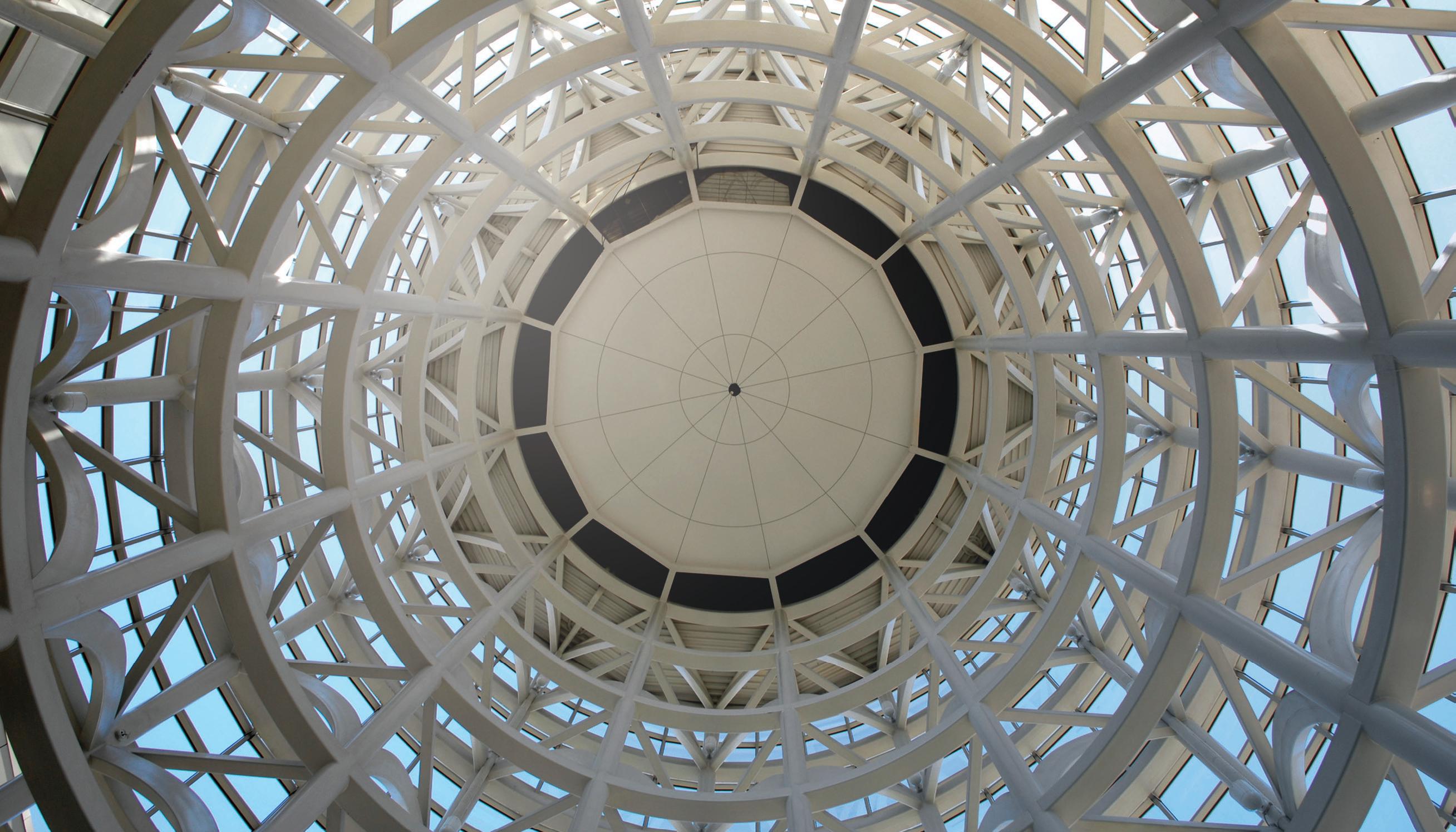
Craig
801-715-9203
Steve
801-715-7364